AMD Ryzen 7 9800X3D vs Intel Core Ultra 9 285K Faceoff — Battle of the Gaming Flagships

Today, we pit Intel's current-gen flagship Core Ultra 9 285K vs Ryzen 7 9800X3D, the hands-down best CPU for gaming on the market, in a heated six-round match to find the winner.
The flagship of Intel’s Arrow Lake-S lineup, the $590 Intel Core Ultra 9 285K, represents the best of the best that Team Blue currently has on offer. As a successor to the powerful Core i9-14900K, the Core Ultra 9 285K ushers in an entirely new platform as well as a brand new naming scheme, for better or for worse.
Going up against the mighty Intel flagship is the $480 Ryzen 7 9800X3D, a high-end desktop CPU from AMD’s Zen 5 lineup, augmented with the acclaimed 3D V-Cache technology. AMD’s standard Zen 5 CPUs certainly put up a good fight against the newest Intel flagship when it comes to CPU benchmarks, but the new X3D processors aim to take a substantial lead in gaming.
We have already taken an in-depth look at both of these CPUs in our detailed reviews, and we have also compared the Core Ultra 9 285K vs the AMD Ryzen 9 9950X3D, but now it's time for a more enticing comparison.
Can the $480 Ryzen 7 9800X3D go toe-to-toe with the $590 Core Ultra 9 285K? Let’s put these two CPUs through our rigorous gauntlet of tests and decide which CPU you should buy for your rig this summer.
Features and Specifications: Intel Core Ultra 9 285K vs AMD Ryzen 7 9800X3D
CPU | Street (MSRP) | Arch | Cores / Threads (P+E) | P-Core Base / Boost Clock (GHz) | E-Core Base / Boost Clock (GHz) | Cache (L2/L3) | TDP / PBP or MTP | Memory |
|---|---|---|---|---|---|---|---|---|
$620 ($590) | Arrow Lake | 24 / 24 (8+16) | 3.7 / 5.7 | 3.2 / 4.6 | 76MB (40+36) | 125W / 250W | CUDIMM DDR5-6400 / DDR5-5600 | |
Ryzen 7 9800X3D | $480 | Zen 5 X3D | 8 / 16 | 4.7 / 5.2 | — | 104MB (8+96) | 120W / 162W | DDR5-5600 |
The Intel Core Ultra 285K and AMD Ryzen 7 9800X3D represent divergent philosophies in modern CPU design, with Intel prioritizing hybrid core scalability and AMD focusing on cache-optimized performance.
The Core Ultra 285K, part of Intel’s Arrow Lake-S lineup, leverages a hybrid architecture with eight high-performance "Lion Cove" P-cores and 16 efficiency-focused "Skymont" E-cores, totaling 24 cores and threads. This setup targets multitasking and heavily threaded workloads, though E-cores are less impactful in latency-sensitive tasks.
Get Tom's Hardware's best news and in-depth reviews, straight to your inbox.
In contrast, the Ryzen 7 9800X3D adopts a monolithic eight-core/16-thread Zen 5 design, augmented by AMD’s 3D V-Cache technology, which stacks an additional 64MB of L3 cache atop the existing 32MB (96MB total). This configuration prioritizes gaming and applications sensitive to memory latency, sacrificing pricing for specialized cache advantages.
Architecturally, the Core Ultra 285K is built on the 3nm production process, promising significant efficiency gains over previous nodes. The Ryzen 7 9800X3D utilizes TSMC’s refined N4P (4nm) process, optimizing power efficiency while retaining compatibility with AM5 motherboards via BIOS updates. Clock speeds diverge sharply: Intel’s chip operates at a base of 3.7 GHz and boosts up to 5.7 GHz on P-cores, while AMD’s X3D variant, constrained by thermal limits from its stacked cache, maintains a lower base of 4.7 GHz and peak boost of 5.2 GHz.
Memory and platform support further highlight their differences. The Core Ultra 285K supports DDR5-6400 natively and requires Intel’s new LGA1851 socket with 800-series chipsets, necessitating motherboard upgrades. It also features a PCIe 5.0 controller and supports Thunderbolt 4.
The Ryzen 7 9800X3D retains compatibility with existing AM5 motherboards (X670/B650), reducing upgrade costs, and supports DDR5-5600 officially, though EXPO overclocking enables higher speeds. AMD’s chip lacks Thunderbolt but includes the PCIe 5.0 interface for GPUs and NVMe storage. Both CPUs align with industry standards, but Intel’s platform demands newer infrastructure for full feature access.
The Core Ultra 285K has a base TDP of 125W and a turbo power limit (PL2) of 250W, typical of Intel’s hybrid architecture under heavy loads. AMD’s Ryzen 7 9800X3D operates at a 120W TDP, with tighter thermal constraints due to the 3D V-Cache’s sensitivity to heat. While Intel’s higher power envelope suits enthusiasts with robust cooling, AMD’s efficiency-focused approach appeals to users prioritizing thermals and noise.
🏆Winner: Tie
The Core Ultra 285K and Ryzen 7 9800X3D cater to distinct user bases. Intel’s hybrid core layout and cutting-edge node aim for productivity supremacy, whereas AMD’s cache-centric design and AM5 stability prioritize gaming and upgradability.
It is up to the potential buyer to decide which specs best cater to their needs, but by the spec sheet alone, Intel is competitive in this round due to its higher core count and clock speed, but AMD's chip comes with a beefy 96MB of L3 cache that the 285K's miserly 36MB simply can't match. That leaves us with a tie in this category.
Gaming Benchmarks and Performance: Intel Core Ultra 9 285K vs AMD Ryzen 7 9800X3D
Below we provide an overview of the gaming performance of both these CPUs, but you can always consult our in-depth reviews for an even more detailed analysis. These benchmark graphs display the average FPS and 1% lows for a wide range of games at 1080p, highlighting the difference between the two CPUs.
We paired the CPUs with the powerful Nvidia GeForce RTX 5090 graphics card to minimize any bottlenecks that may occur. This particular test configuration is ideal for analyzing the difference in CPU performance without worrying about a GPU bottleneck.



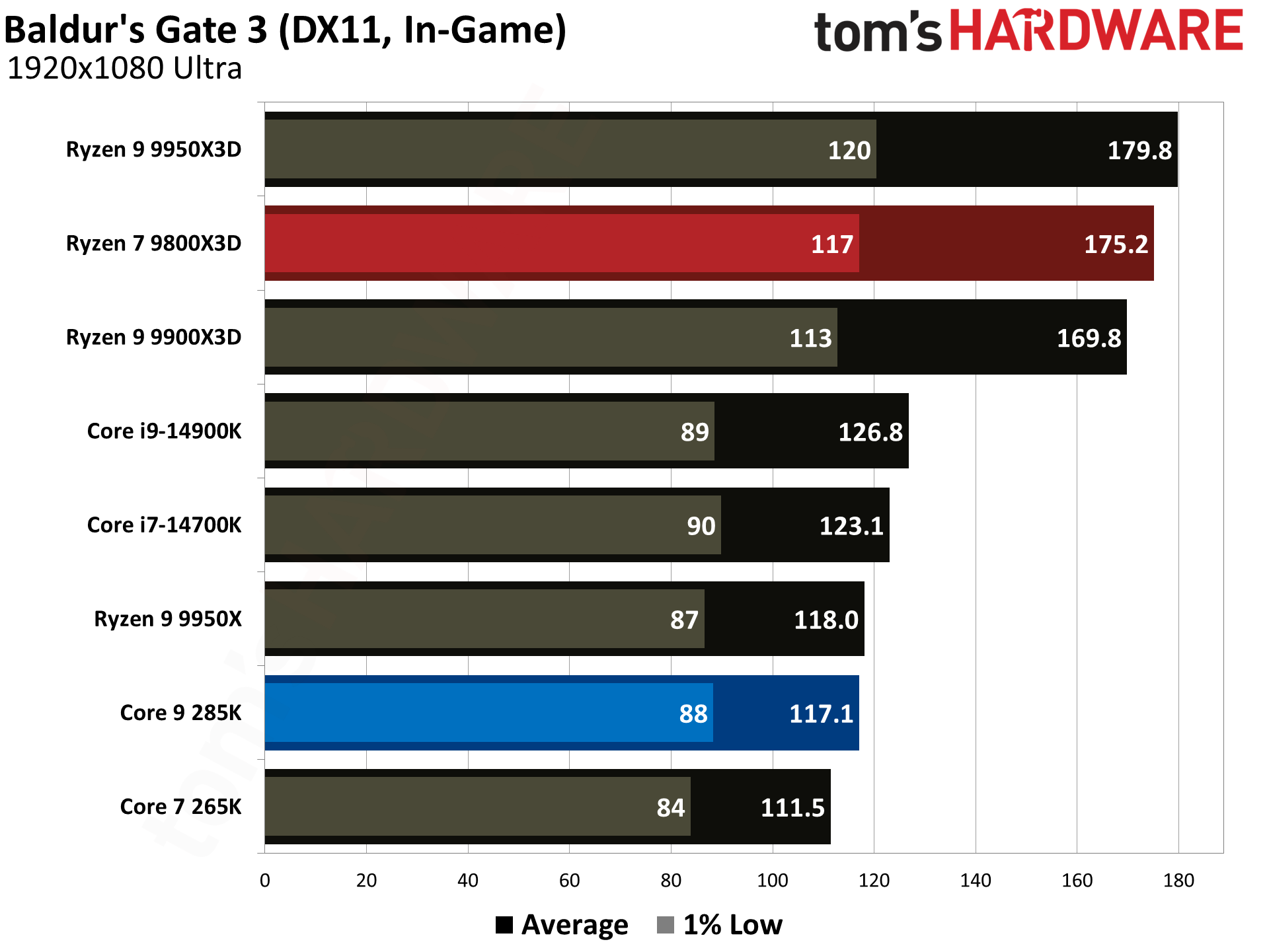
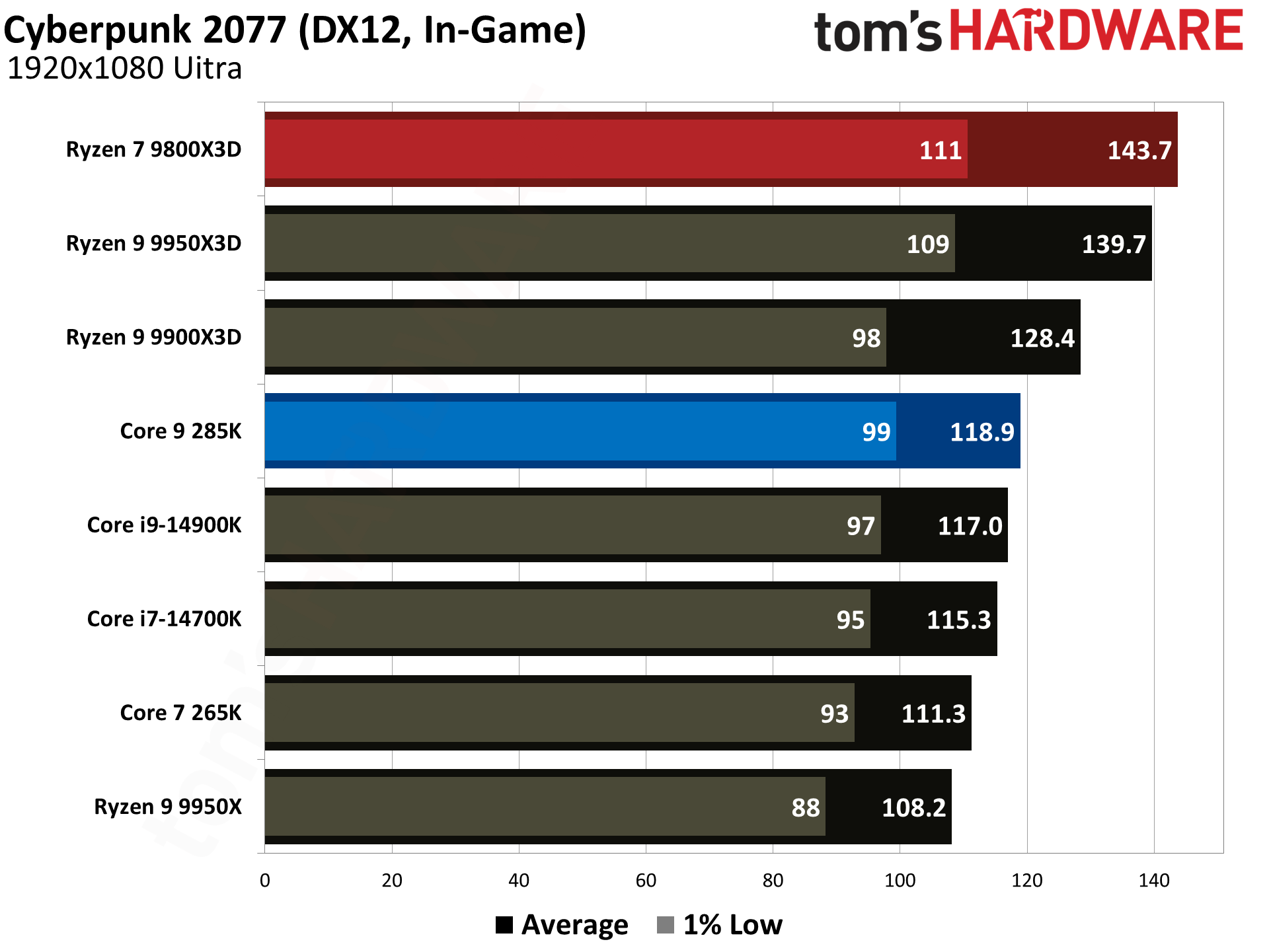
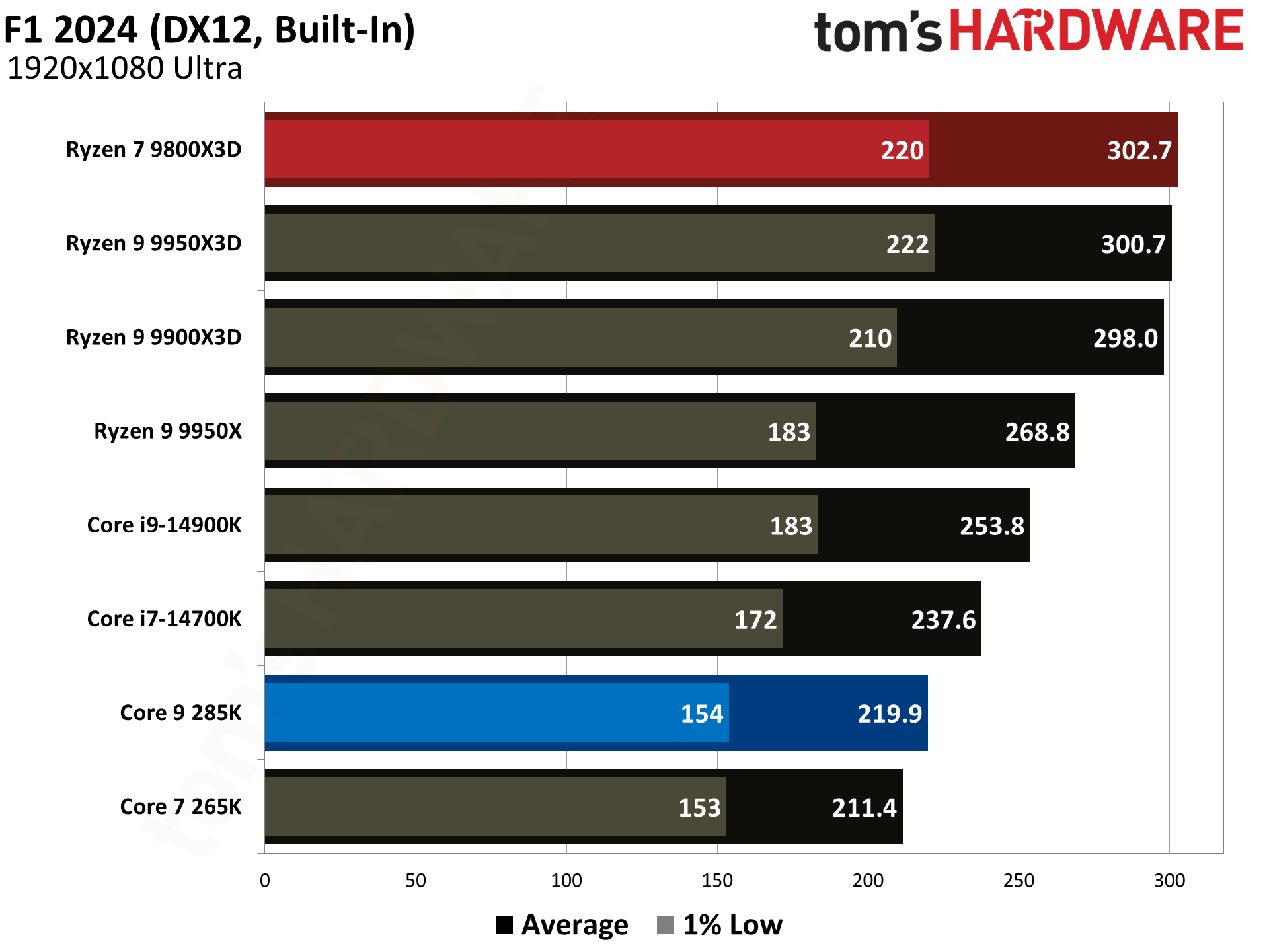



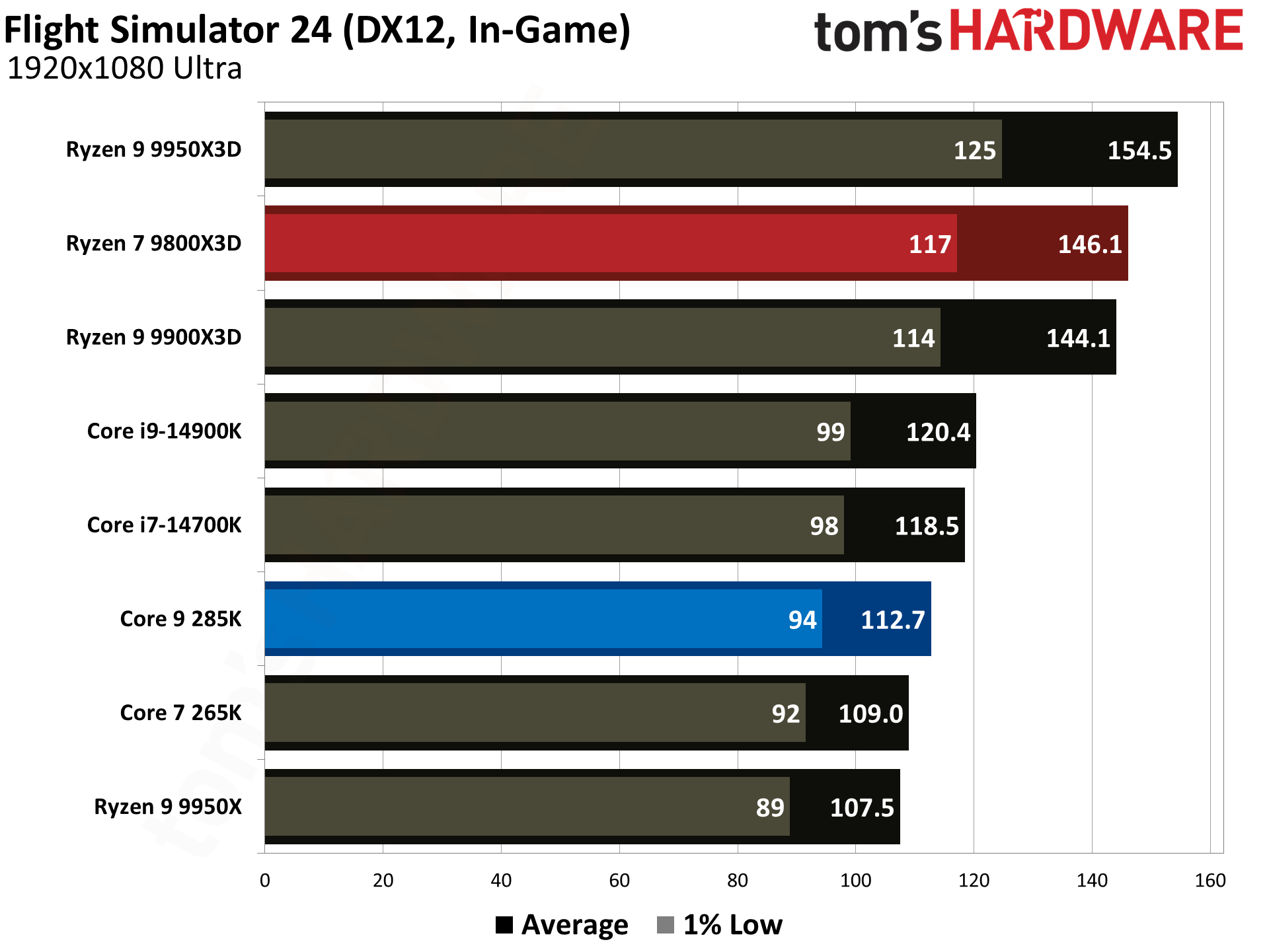
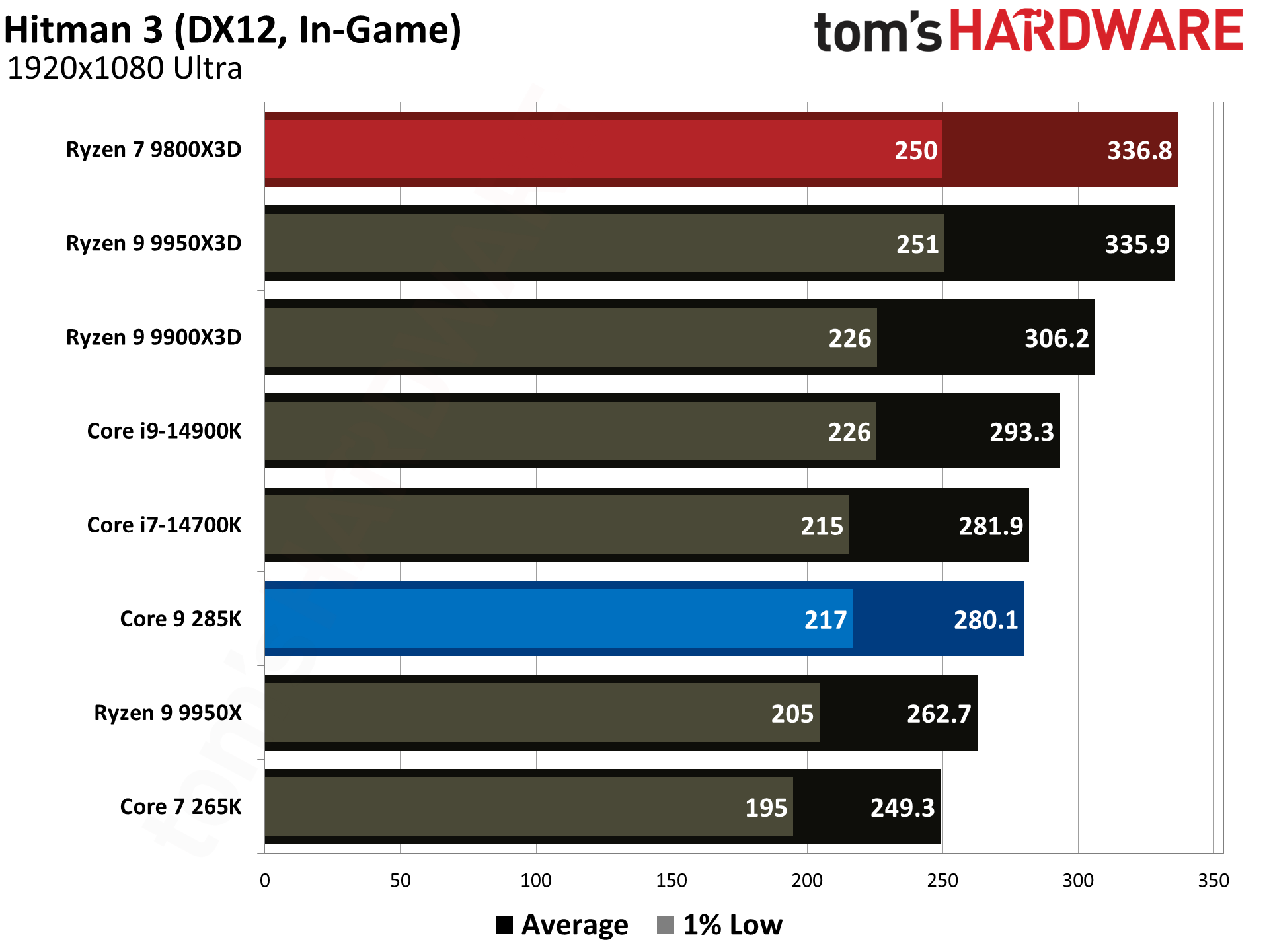
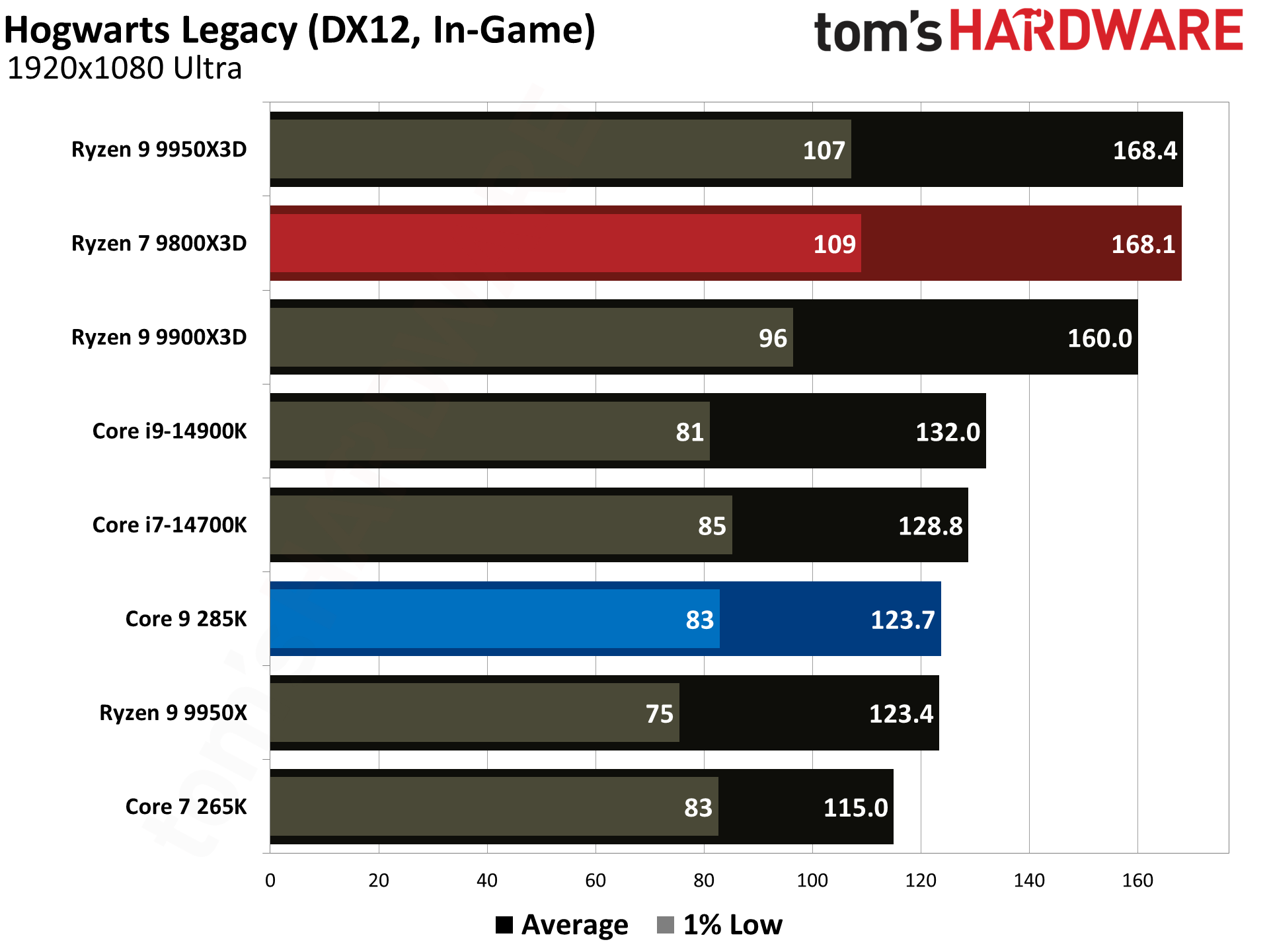
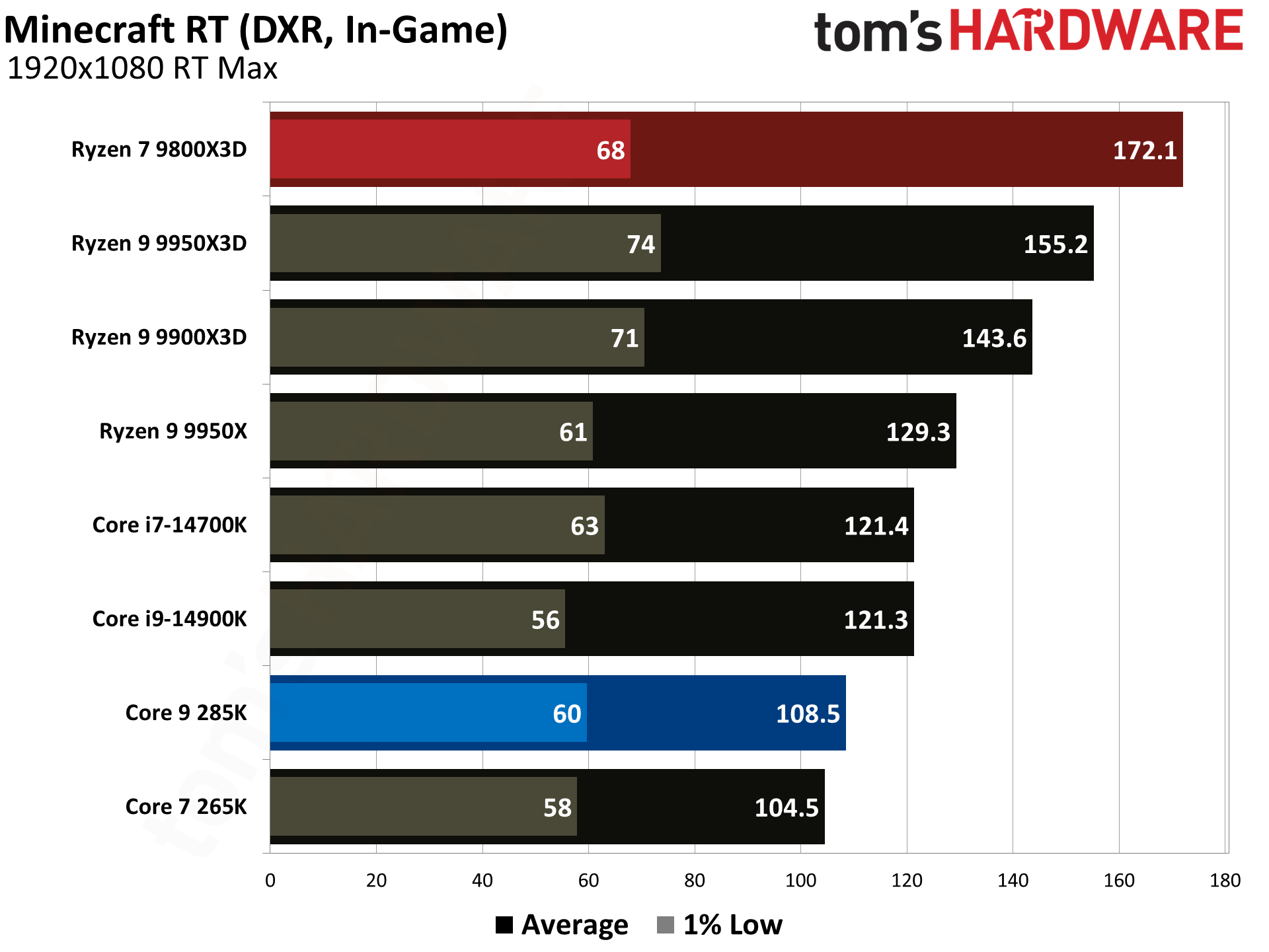
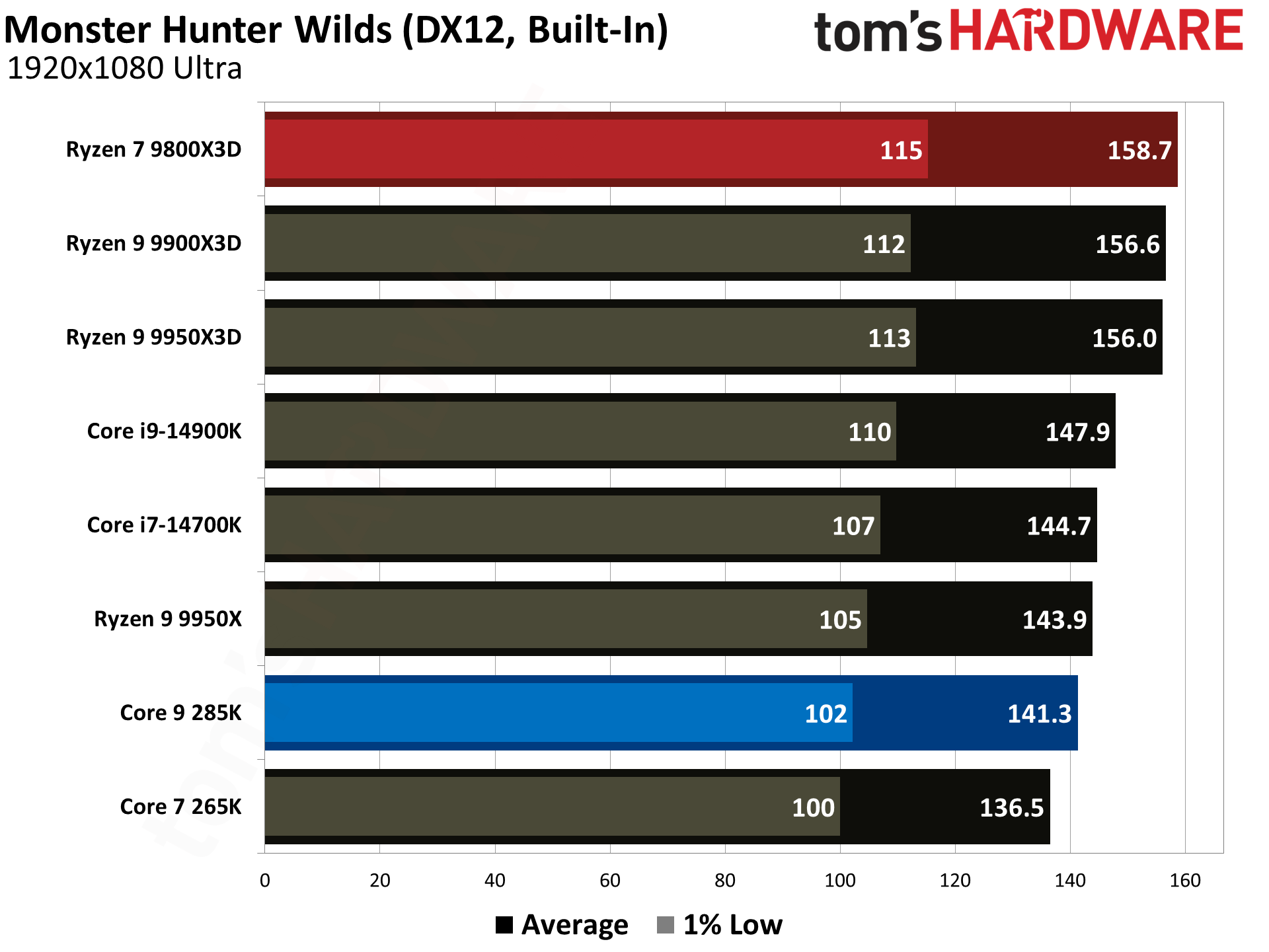
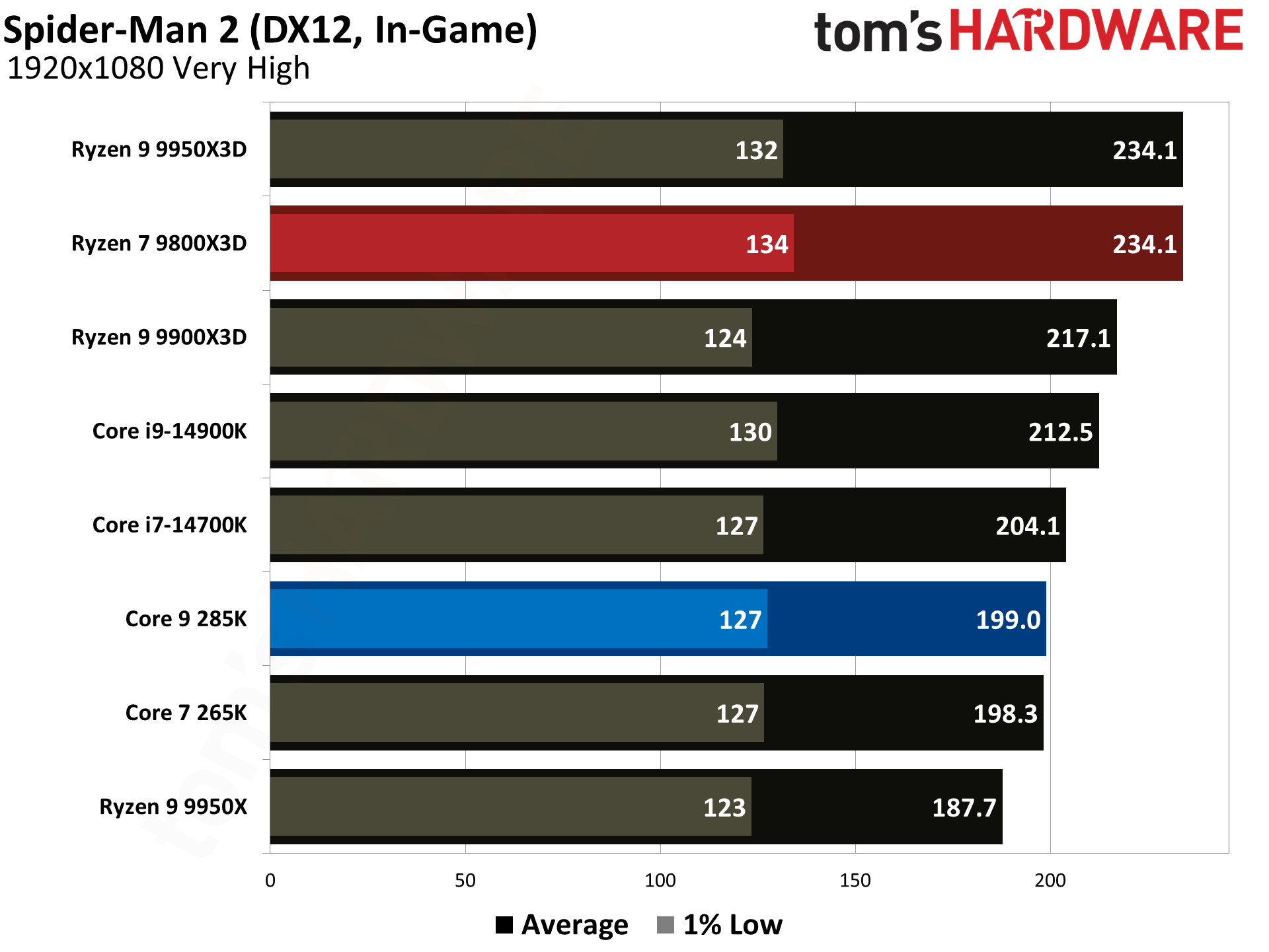
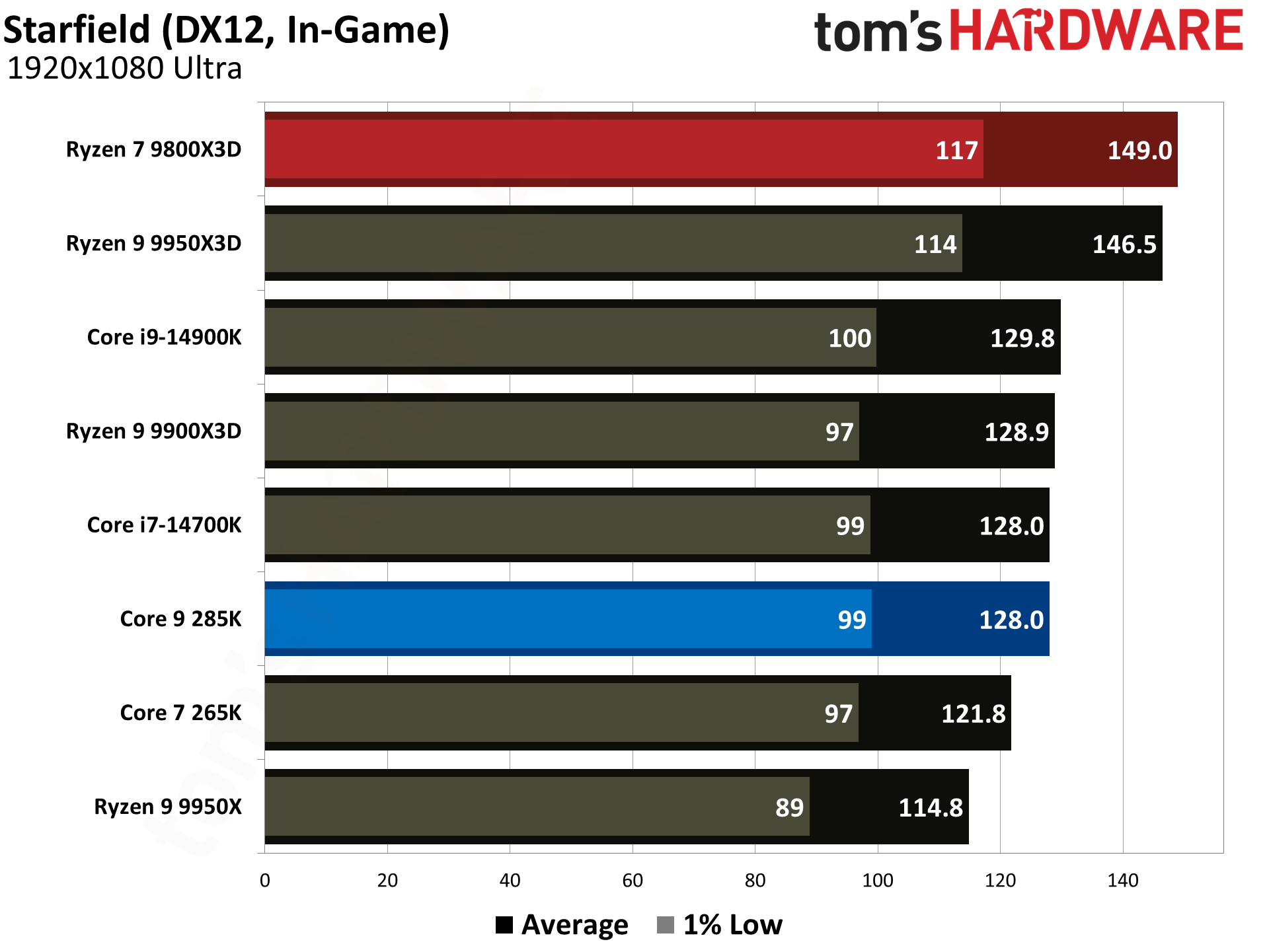
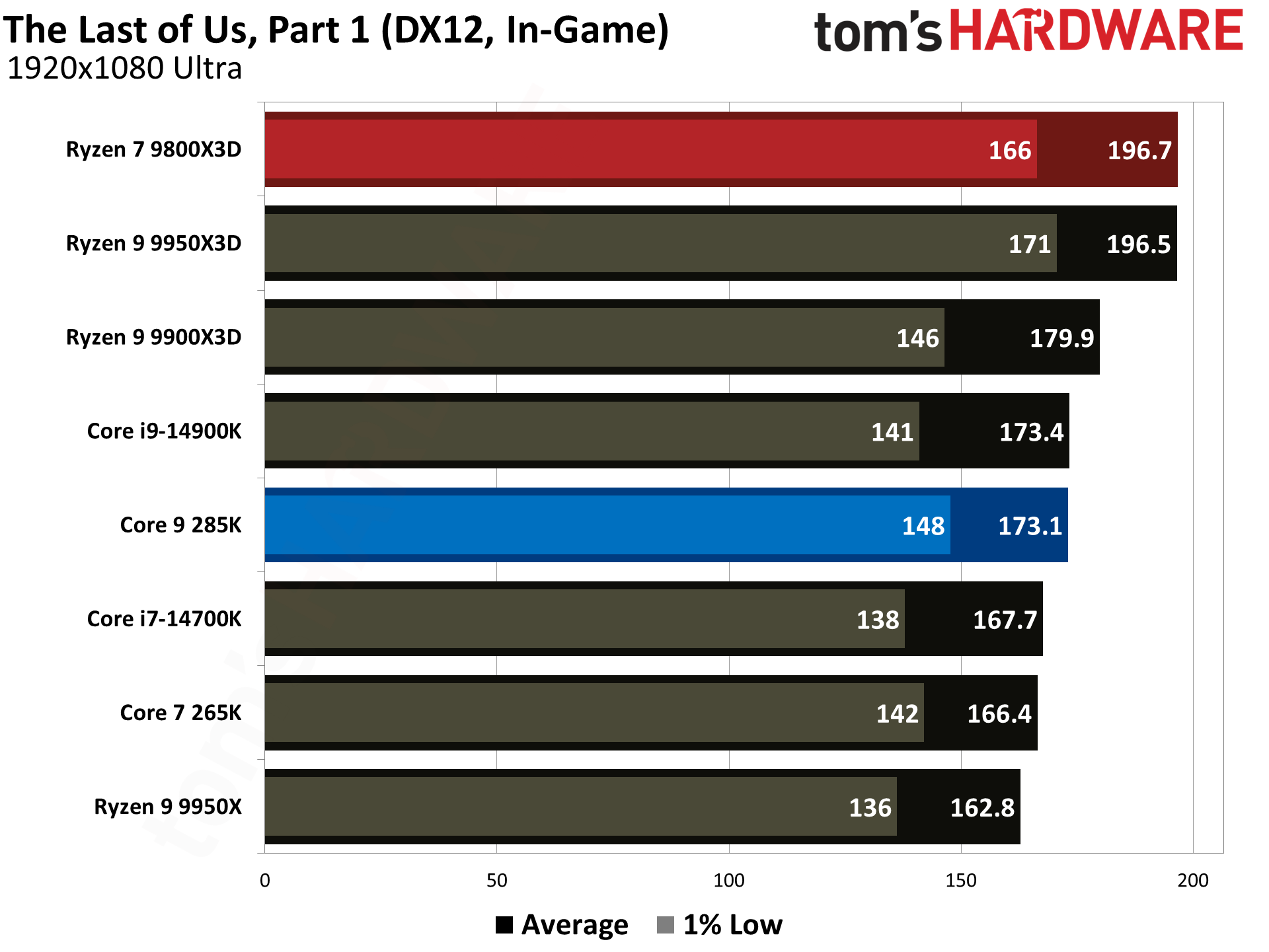
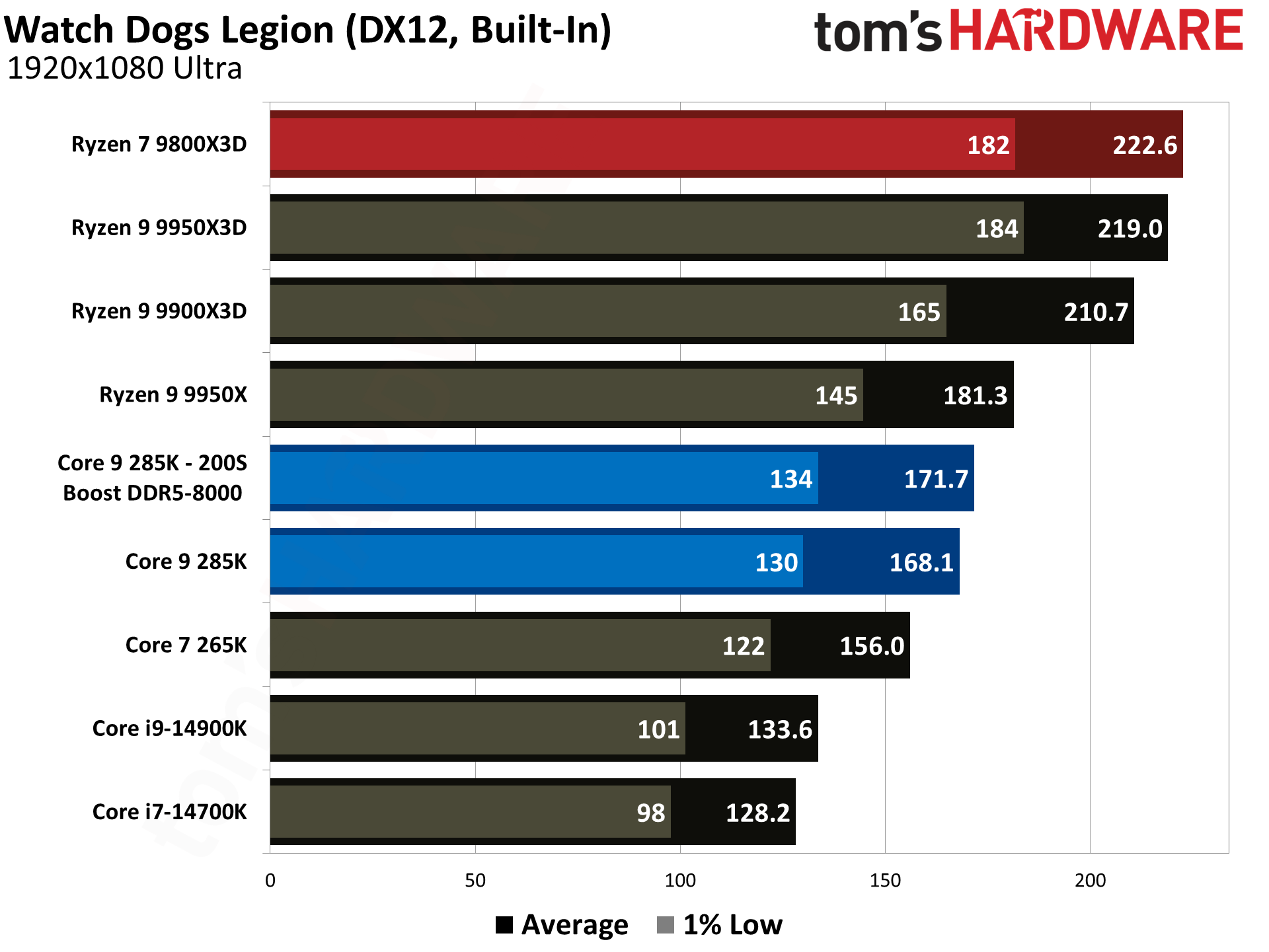

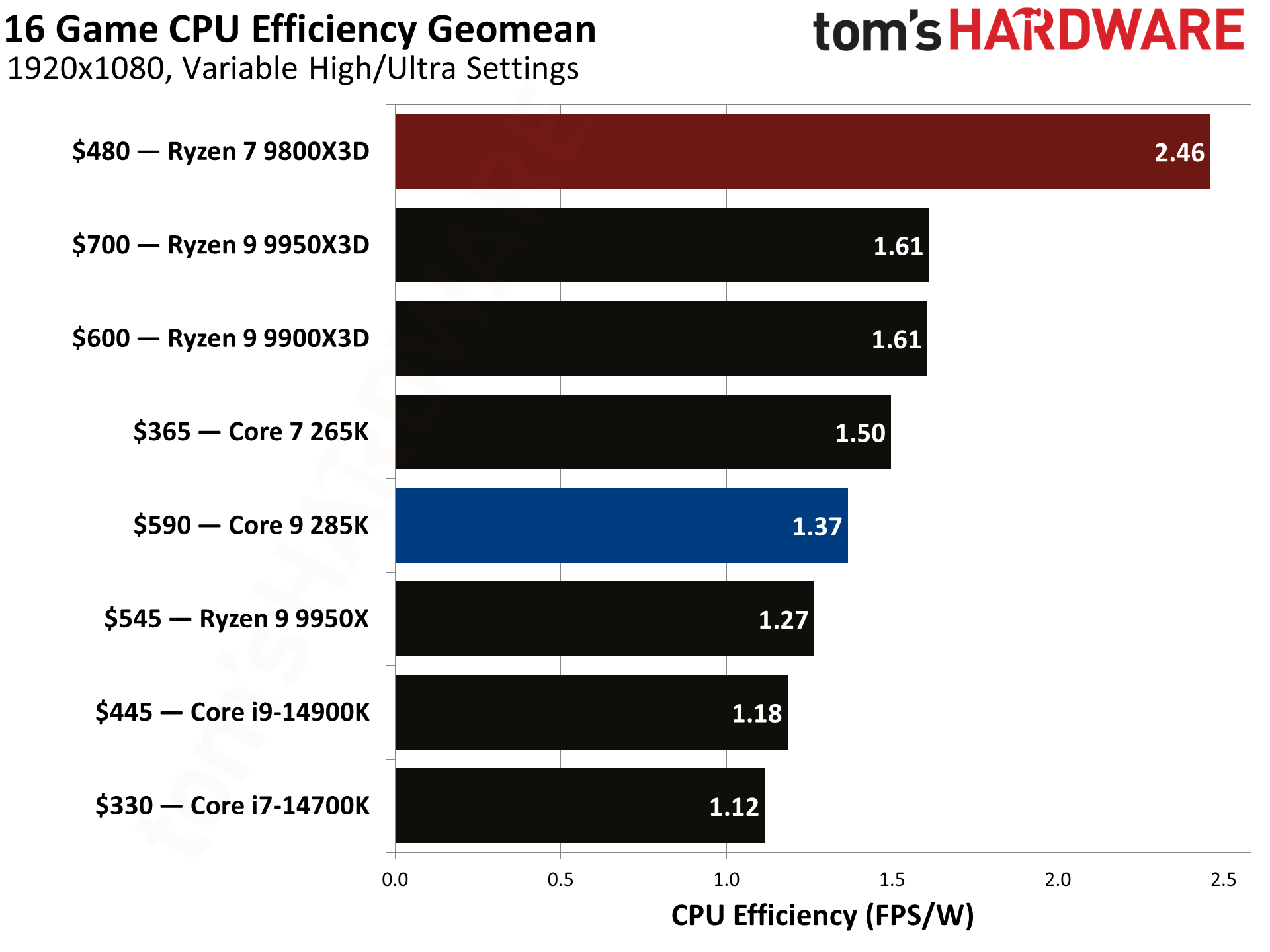
The gaming performance comparison between the AMD Ryzen 7 9800X3D and Intel Core 9 285K is a beatdown, with the AMD processor coming out on top. Based on our thorough testing results, the Ryzen 7 9800X3D delivers an average of 195.5 FPS across 16 games at the 1080p resolution, which is approximately 35% faster than the Core 9 285K's 144.9 FPS average. This performance gap represents a significant advantage for AMD, especially considering the Ryzen 7 9800X3D is priced at $480 compared to the Core 9 285K's $590 price tag.
When examining frame consistency, which is critical for smooth gameplay, the difference is also noticeable. The Ryzen 7 9800X3D maintains a 1% low framerate of 134 FPS, compared to the Core 9 285K's 107 FPS. This 25% advantage in minimum framerates means the AMD chip provides noticeably smoother gameplay with fewer stutters or frame drops during graphically intensive moments.
The exceptional gaming performance of the Ryzen 7 9800X3D can be directly attributed to AMD's innovative 3D V-Cache technology. This architecture stacks additional L3 cache vertically on the CPU die, dramatically increasing the total cache available to the processor. While the Core 9 285K relies on traditional cache arrangements, the Ryzen's expanded cache capacity allows it to store substantially more game data close to the execution cores, reducing the need to access slower system RAM.
The Ryzen 7 9800X3D's dominance is particularly pronounced in titles like Baldur's Gate 3 and Cyberpunk 2077. In Baldur's Gate 3, the 9800X3D delivers 175.2 FPS on average (117 FPS 1% low), while the 285K manages only 117.1 FPS (88 FPS 1% low)—a 49% advantage for AMD. Similarly, in Cyberpunk 2077, the 9800X3D achieves 143.7 FPS (111 FPS 1% low) compared to the 285K’s 118.9 FPS (99 FPS 1% low), a 20.9% advantage. These gains are a direct result of the 3D V-Cache's ability to keep frequently accessed game data readily available, minimizing stalls and improving frame pacing.
What makes the 3D V-Cache so effective for gaming, specifically, is how modern games access memory. Games typically have non-sequential memory access patterns with limited predictability, making them highly sensitive to memory latency rather than just bandwidth. The Ryzen 7 9800X3D's larger cache serves as an effective buffer against these memory access penalties, keeping more critical game data close to the execution cores. This directly translates to the 35% higher average frame rates and 25% better frame consistency demonstrated in our benchmark results.
From a value perspective, the comparison becomes even more favorable toward AMD. Not only does the Ryzen 7 9800X3D outperform the Intel Core 9 285K by a substantial margin, but it also costs approximately $120-140 less. This creates a scenario where gamers get significantly better performance while spending nearly 25% less on their CPU.
🏆Winner: AMD
For competitive gamers seeking every possible advantage, the Ryzen 7 9800X3D's 35% faster average gaming performance provides headroom that could be crucial in high-refresh-rate gaming scenarios. The smoother frame delivery, evidenced by the 1% low metrics, also contributes to more consistent input response and system predictability.
The Ryzen 7 9800X3D's 3D V-Cache gives it a decisive edge over the Core 9 285K in gaming, delivering higher average FPS, smoother 1% lows, and better scalability. While the 285K remains a capable gaming CPU, it cannot overcome the architectural advantages of AMD's cache-rich design, making the 9800X3D the clear choice for enthusiasts prioritizing raw gaming performance.
Productivity Performance: Intel Core Ultra 9 285K vs AMD Ryzen 7 9800X3D
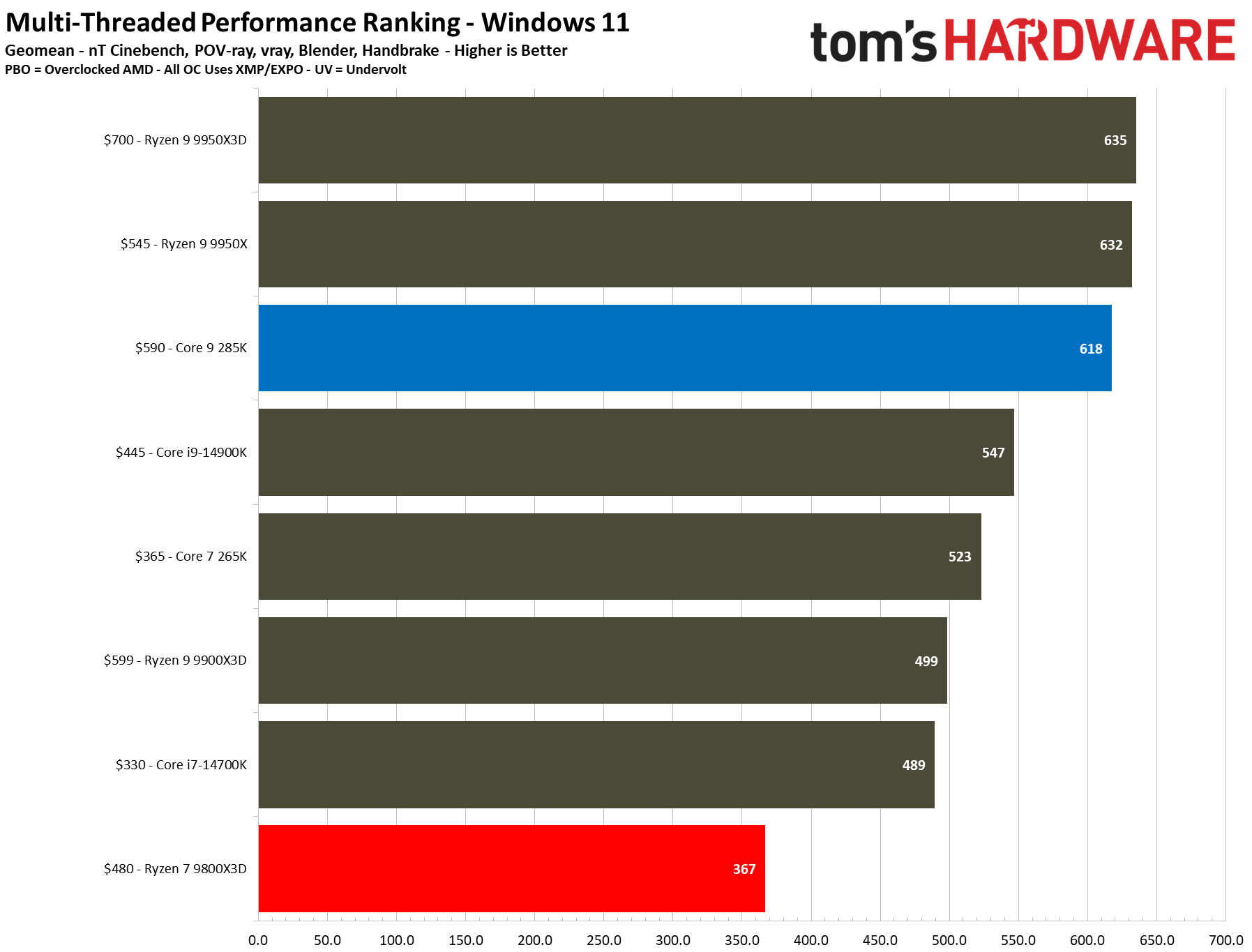
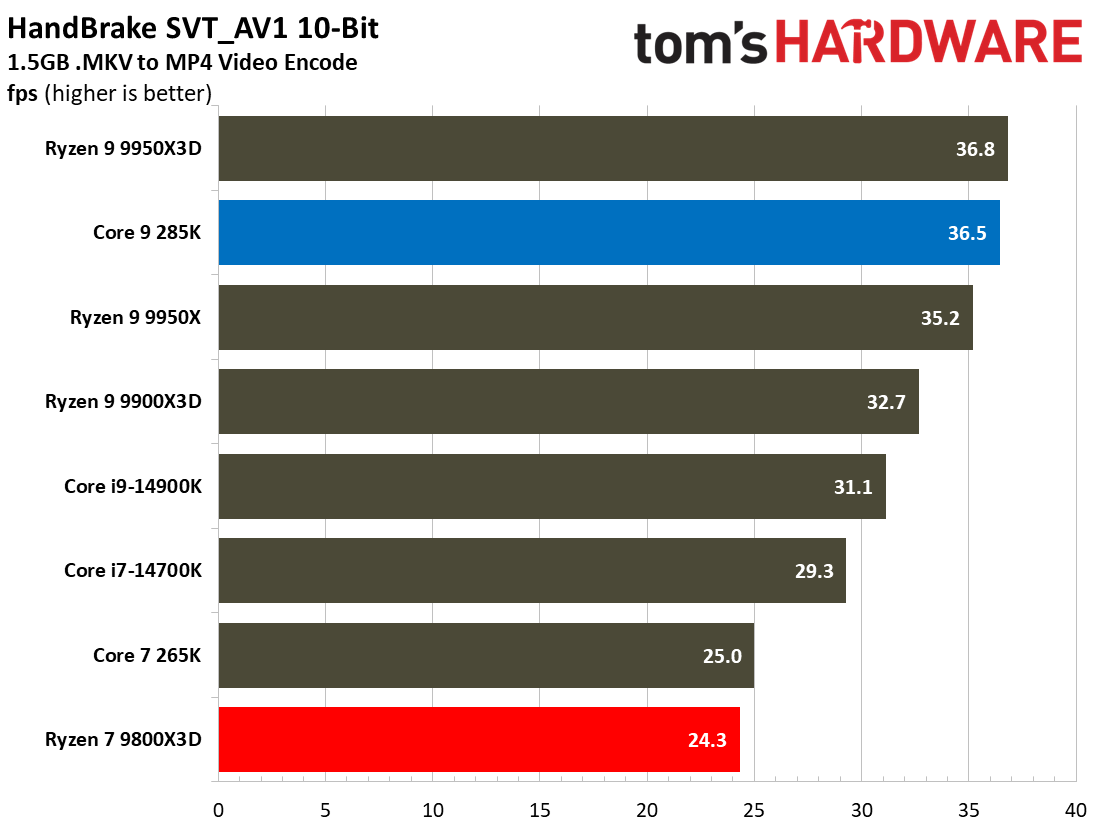
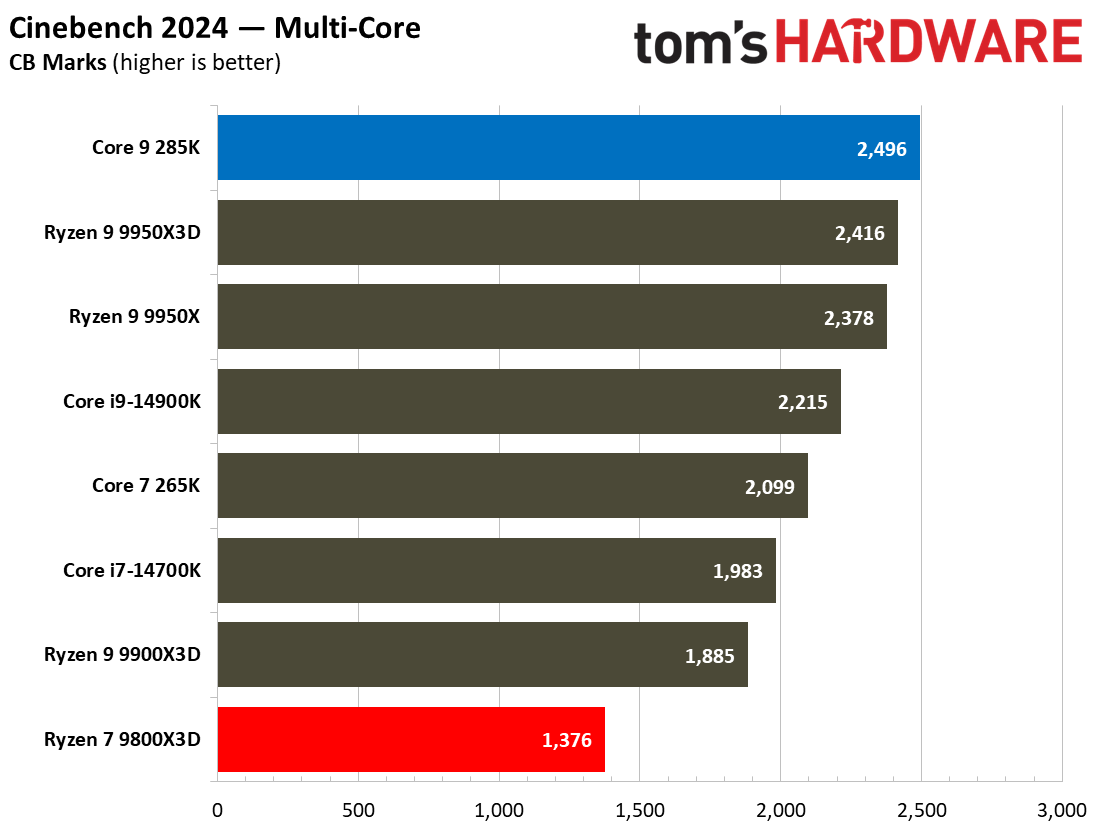
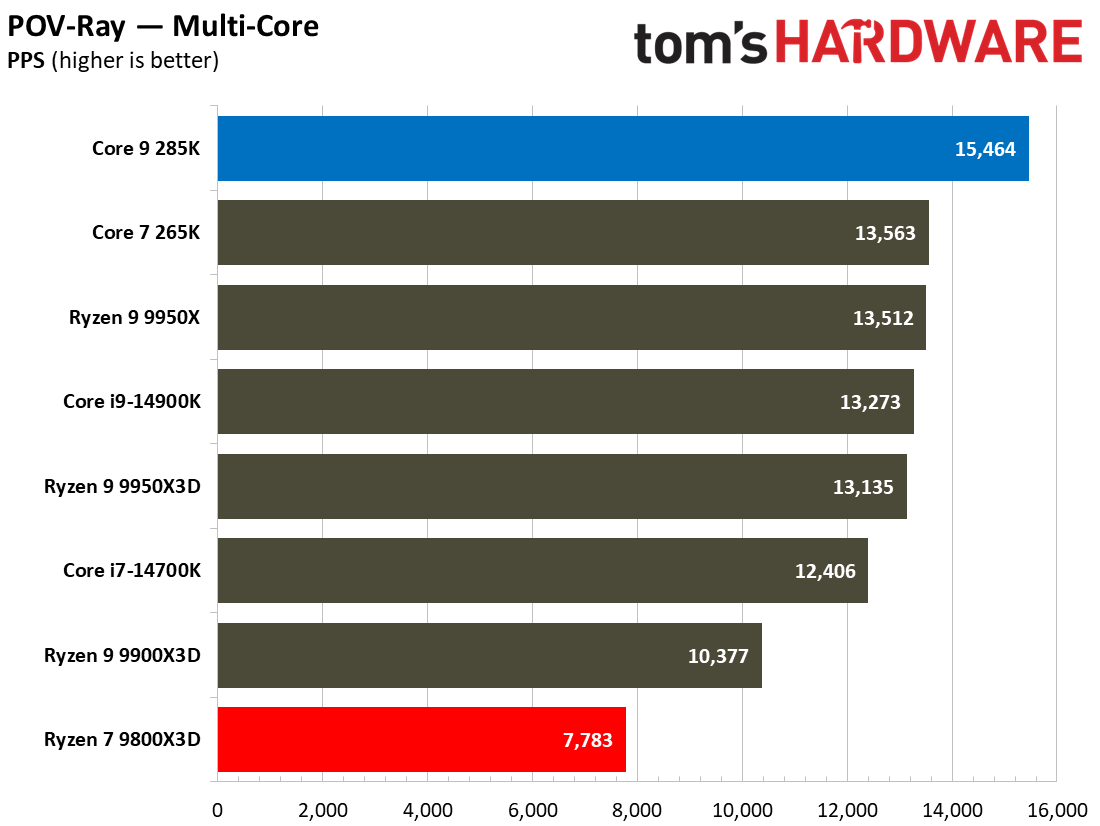
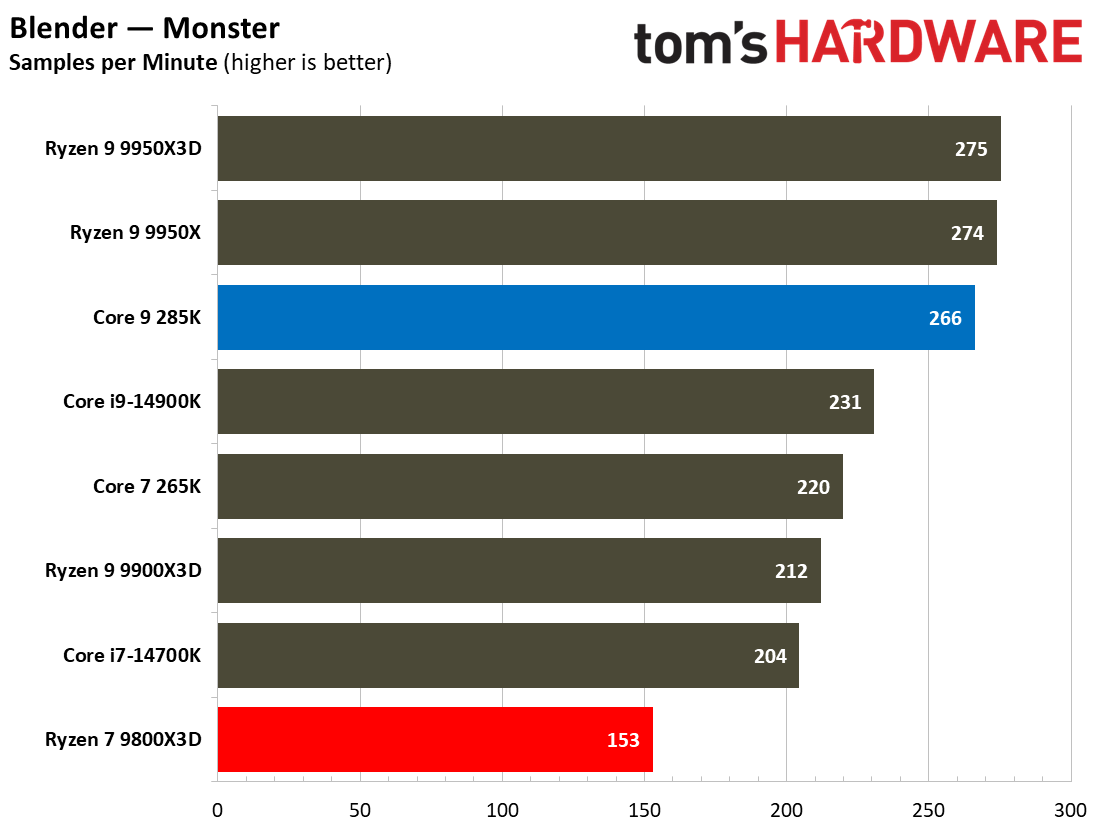
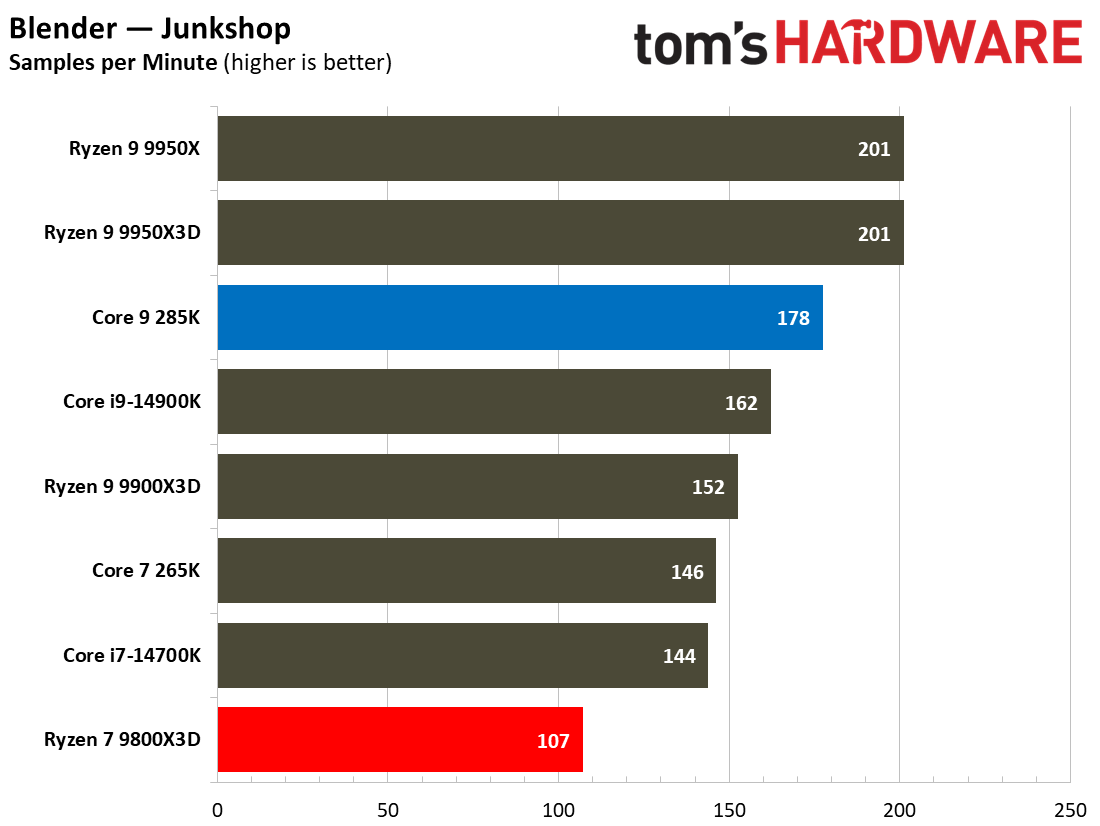
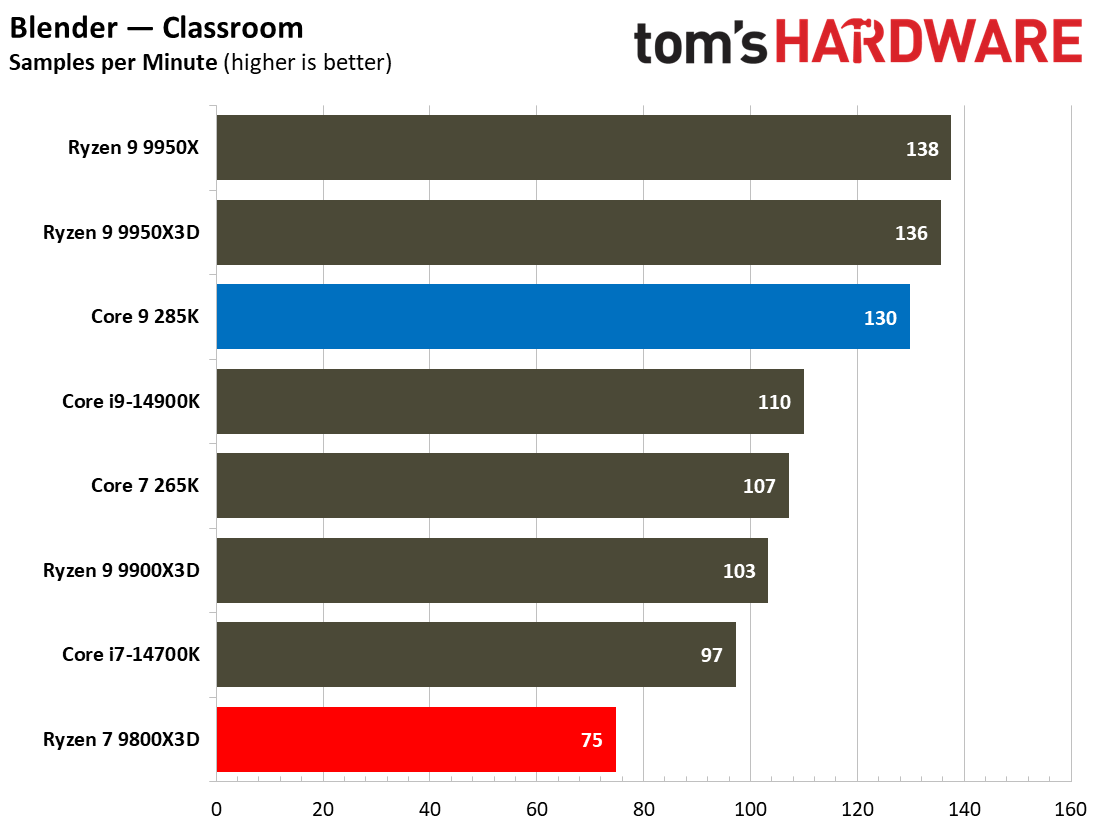
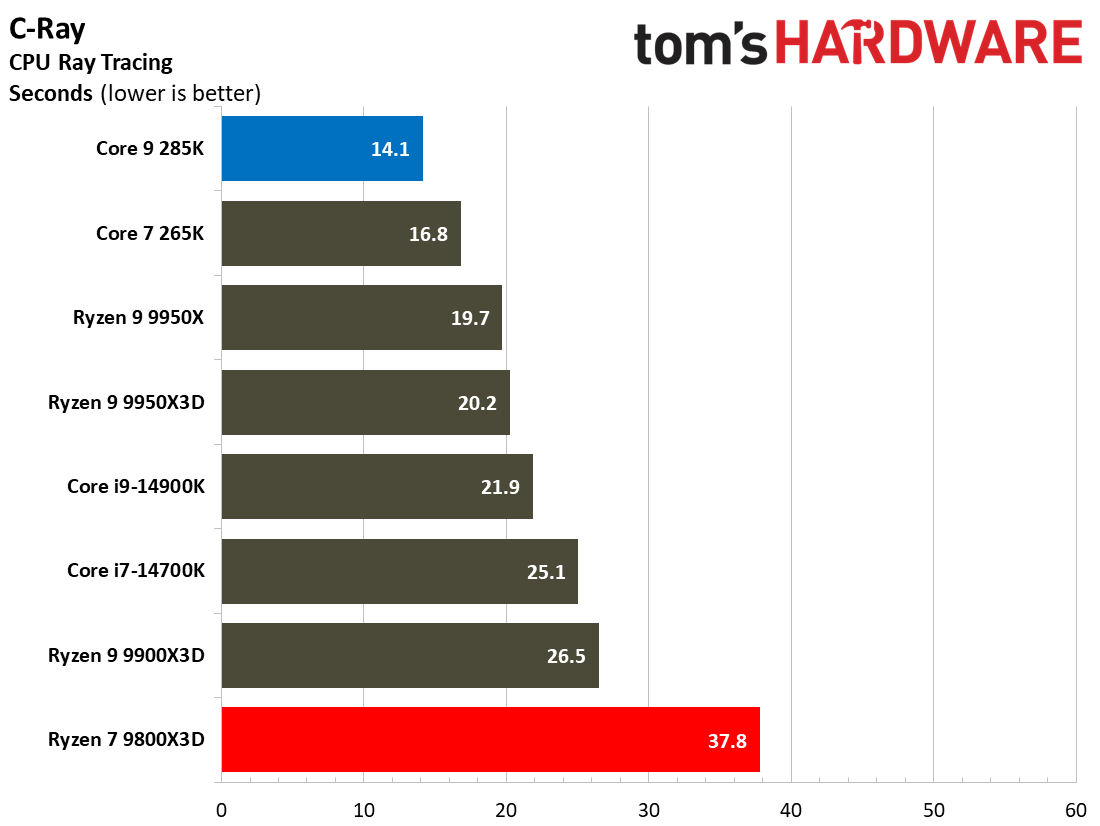
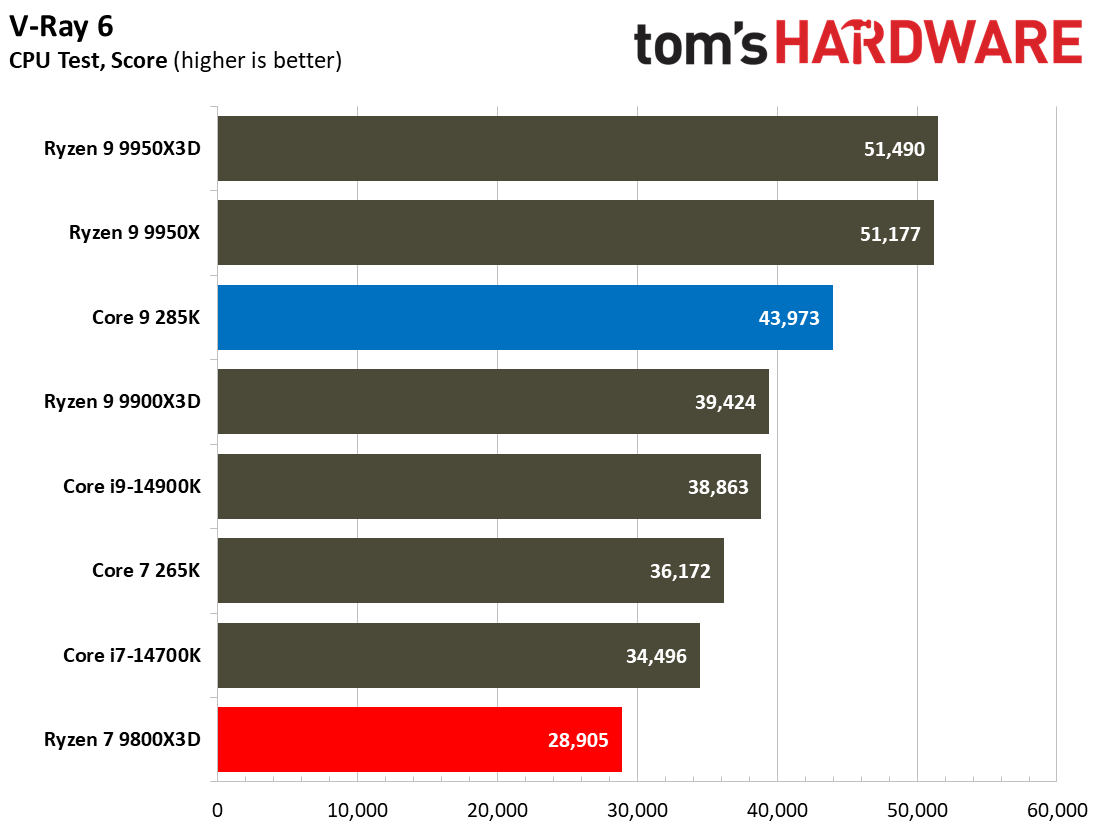


The Intel Core Ultra 9 285K and AMD Ryzen 7 9800X3D exhibit stark differences in productivity performance, particularly in multi-threaded workloads. In Cinebench 2024’s multi-core benchmark, the 285K scores 2496, outpacing the 9800X3D’s 1376 by 81%, a decisive advantage in favor of Team Blue. This significant lead highlights the Core Ultra 9 285K’s superior scalability across multiple cores, making it a powerhouse for heavily parallelized workloads, such as 3D rendering, video encoding, or simulation tasks.
This gap widens further in POV-Ray’s multi-core test, where the 285K achieves 15,464 PPS compared to the 9800X3D’s 7,783—a 98.6% lead. These results highlight Intel’s dominance in raw multi-threaded throughput, likely due to its higher core and thread count, as well as its architectural efficiency in distributed workloads.

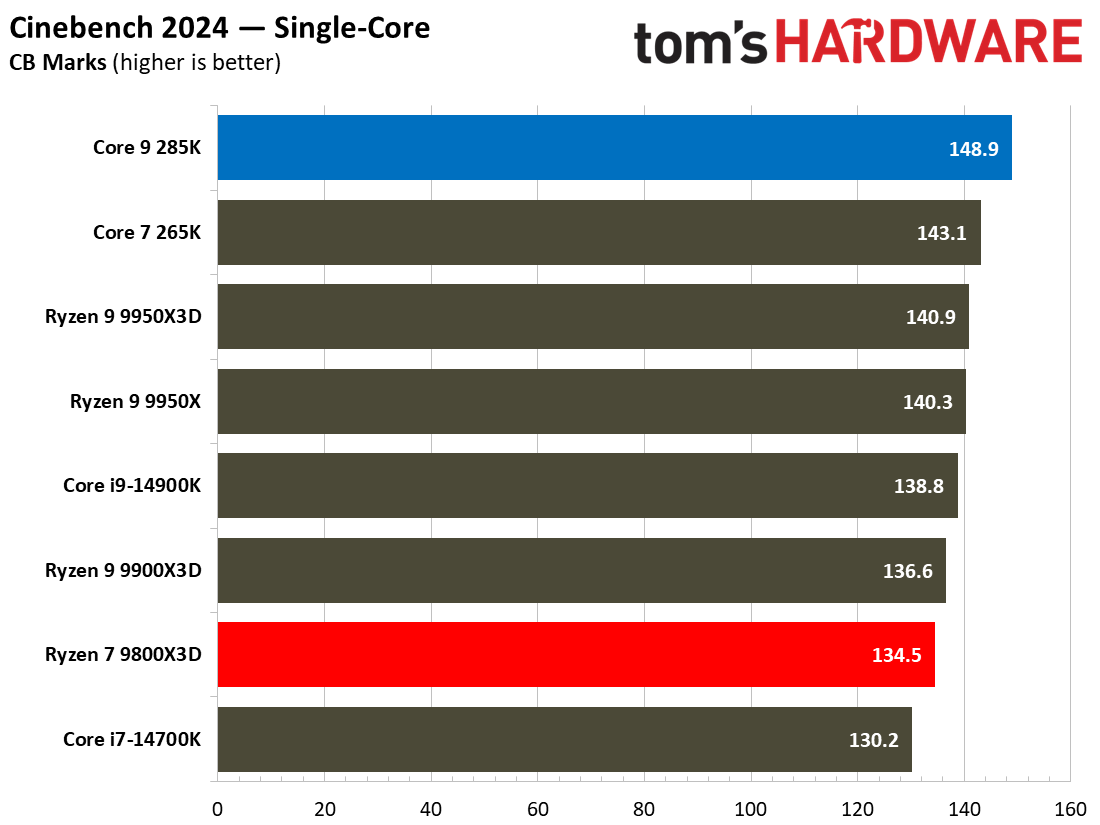
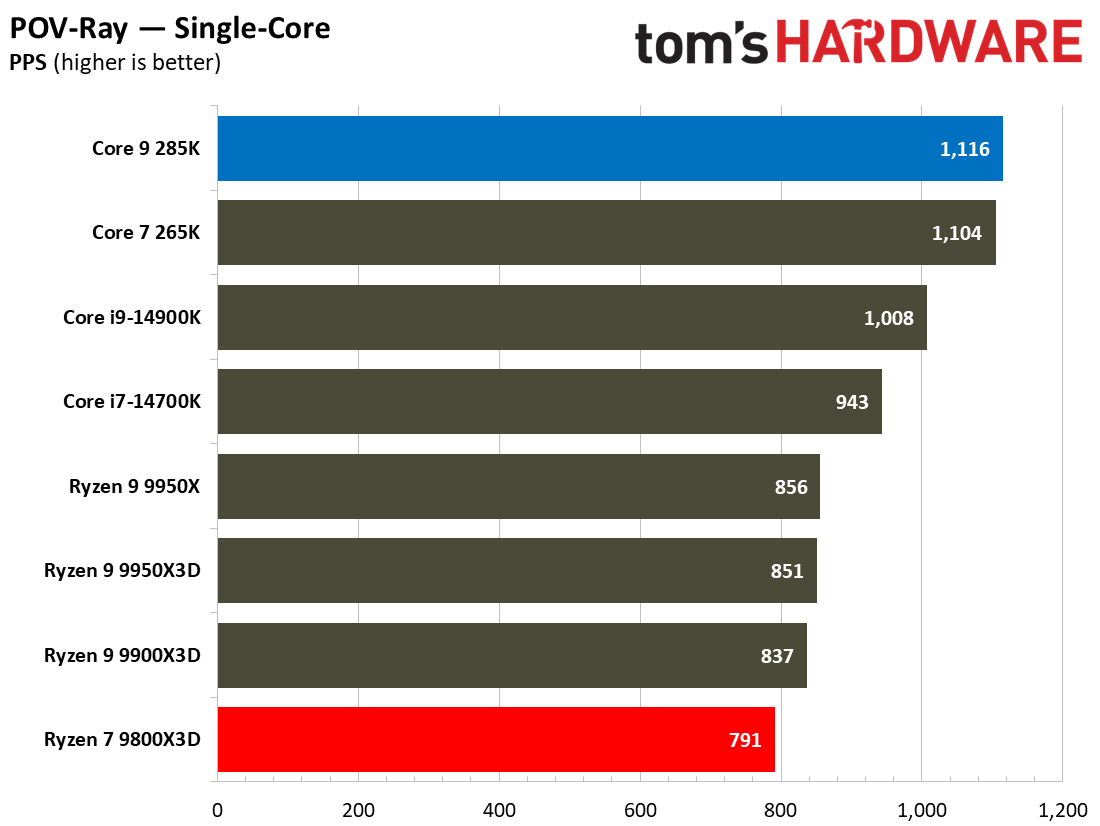
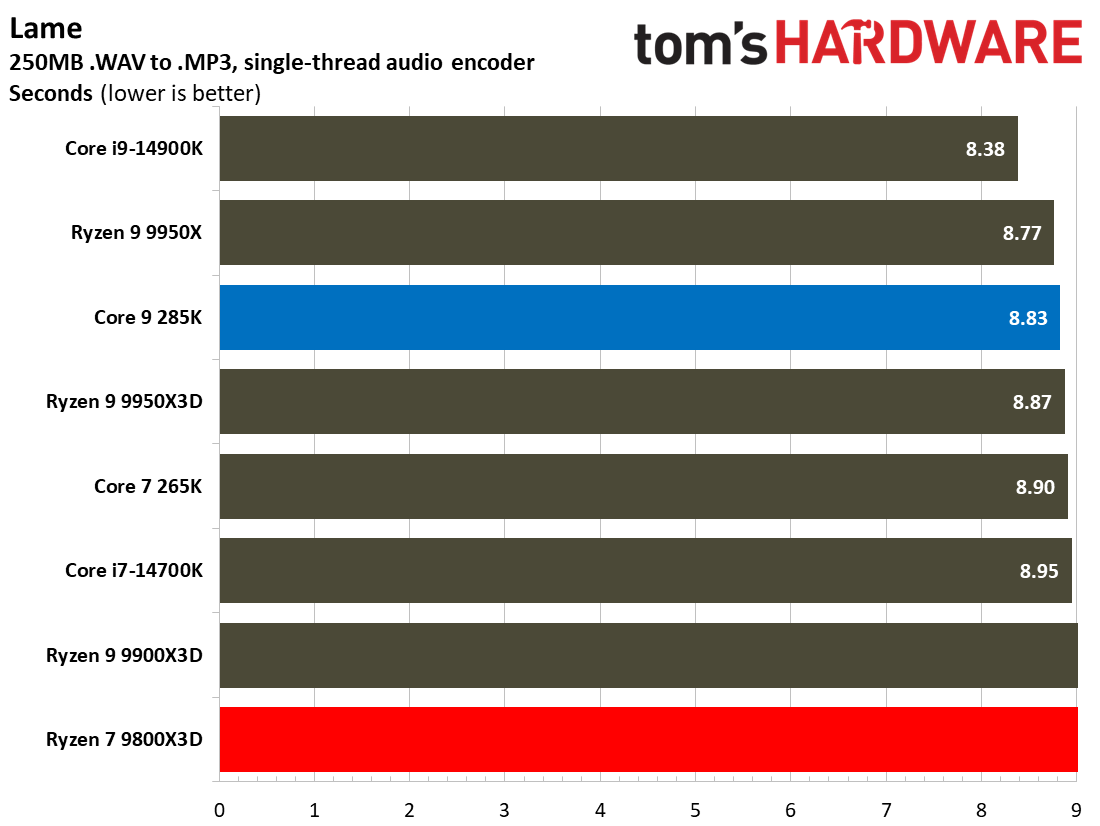

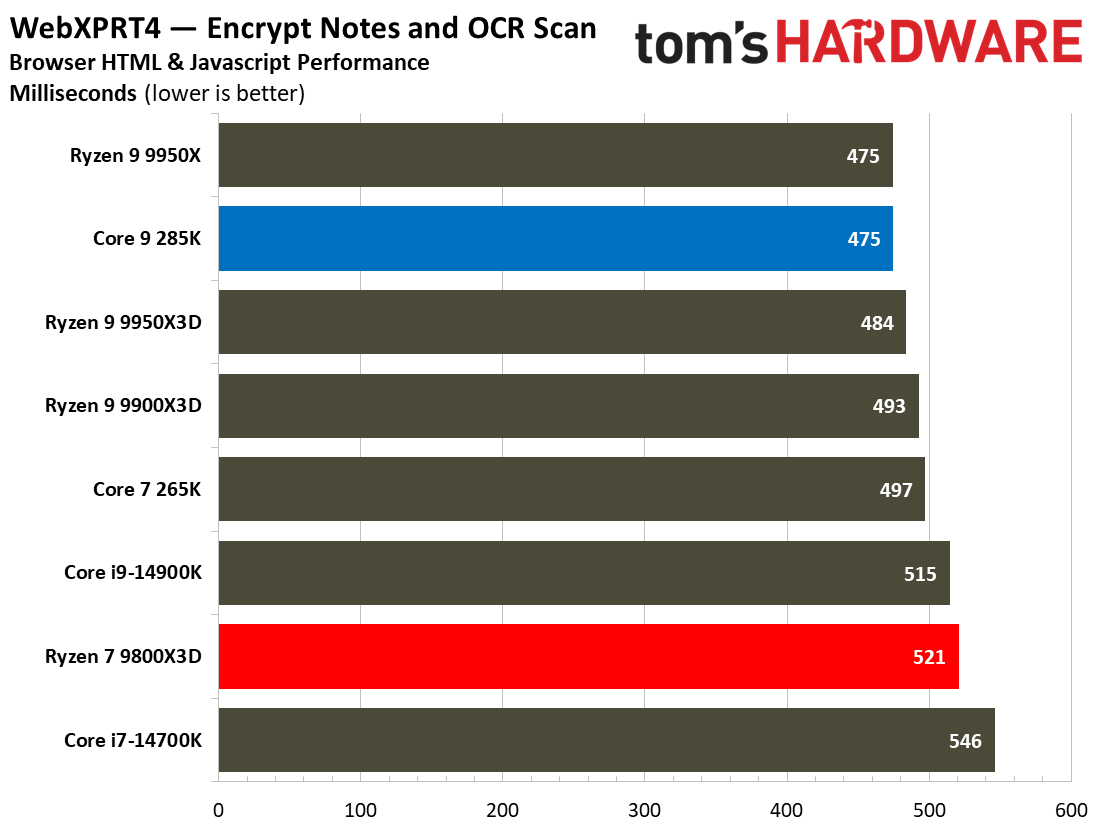

Single-threaded performance, while less lopsided, still favors the 285K. In Cinebench 2024’s single-core test, the 285K scores 148.9, edging out the 9800X3D’s 134.5 by 10.7%. The disparity grows in POV-Ray’s single-core benchmark, where the 285K’s 1,116 PPS outperforms the 9800X3D’s 791 by 41%.
The Lame benchmark, which measures single-threaded audio encoding (converting a 250MB WAV to MP3), shows a closer race, with the Core Ultra 9 285K completing the task in 8.83 seconds versus the Ryzen 7 9800X3D’s 9.05 seconds—a difference of 0.22 seconds, or roughly 2.4%. Intel’s superior single-threaded performance suggests advantages in latency-sensitive tasks like application startup or lightly threaded software.
The overall geomean rankings reinforce these trends. In multi-threaded productivity, the 285K occupies a higher tier, while the 9800X3D lags significantly by a margin of nearly 69%. The single-threaded Geomean places the 285K at 276 versus the 9800X3D’s 243, a 13.6% delta. These metrics underscore Intel’s consistent lead across both workload types, though AMD’s lower price ($480 vs $590) may appeal to budget-focused users willing to trade peak performance for value.
The Core Ultra 9 285K’s architecture, likely benefiting from higher clock speeds and improved IPC (instructions per cycle), gives it an edge in single-threaded scenarios, while its higher core and thread count, paired with efficient multi-core scaling, drive its dominance in multi-threaded tests.
🏆Winner: Intel
The Core Ultra 9 285K is the unequivocal choice for users prioritizing maximum multi-threaded performance, with leads exceeding 80% in key benchmarks. The 9800X3D, while more affordable, struggles to compete in these scenarios, making it better suited for gaming-focused builds or workloads where its cache architecture can mitigate its raw compute shortcomings. For general productivity, Intel’s offering delivers a compelling performance premium, albeit at a higher cost.
Overclocking: Intel Core Ultra 9 285K vs AMD Ryzen 7 9800X3D
The Intel Core Ultra 9 285K and AMD Ryzen 7 9800X3D exhibit fundamentally different approaches to overclocking, reflecting their architectural priorities. Intel’s platform emphasizes granular control, offering unlocked multipliers for both performance (P) and efficiency (E) cores, along with separate voltage adjustments for each core type. This allows enthusiasts to fine-tune frequencies in small increments while balancing power delivery across the hybrid architecture.
The processor’s thermal design also supports aggressive tuning, with a configurable TjMax up to 115°C compared to AMD’s 95°C limit. However, Intel’s overclocking potential remains constrained by the inherent complexity of managing 24 heterogeneous cores (8P+16E), requiring careful coordination between core types.
AMD’s Ryzen 7 9800X3D breaks new ground for 3D V-Cache processors by introducing Precision Boost Overdrive (PBO) support, marking the first time an X3D chip has official overclocking capabilities. The redesigned cache placement—now beneath the compute die rather than stacked atop it—improves thermal conductivity, addressing a key limitation that previously restricted manual tuning on X3D models.
While the multiplier remains unlocked, AMD’s approach prioritizes automated frequency optimization through its boost algorithms, with manual adjustments primarily focusing on power limits and thermal thresholds rather than raw clock speeds. This reflects the inherent challenges of overclocking cache-sensitive designs.
Intel’s platform offers a more traditional overclocking experience, featuring extensive BIOS-level controls, including per-core frequency adjustments and independent voltage regulation for different core types. This makes the Core Ultra 9 285K better suited for enthusiasts willing to invest time in meticulous tuning.
AMD’s solution offers greater accessibility through its Ryzen Master software, which simplifies PBO configuration while maintaining safeguards for the delicate 3D cache structure.
🏆Winner: Intel
For most users, the 9800X3D’s automated boost algorithms deliver near-maximum performance without manual intervention, but it lacks Intel’s depth of low-level control. Ultimately, the Core Ultra 9 285K’s architectural flexibility and higher thermal limits make it the more overclocking-friendly option for dedicated tuners, while the 9800X3D prioritizes out-of-the-box efficiency with limited but accessible manual tuning capabilities
Power Consumption, Efficiency, and Cooling: Intel Core Ultra 9 285K vs AMD Ryzen 7 9800X3D
The Intel Core Ultra 9 285K and AMD Ryzen 7 9800X3D exhibit distinct power consumption profiles across idle and load scenarios, reflecting their architectural differences.
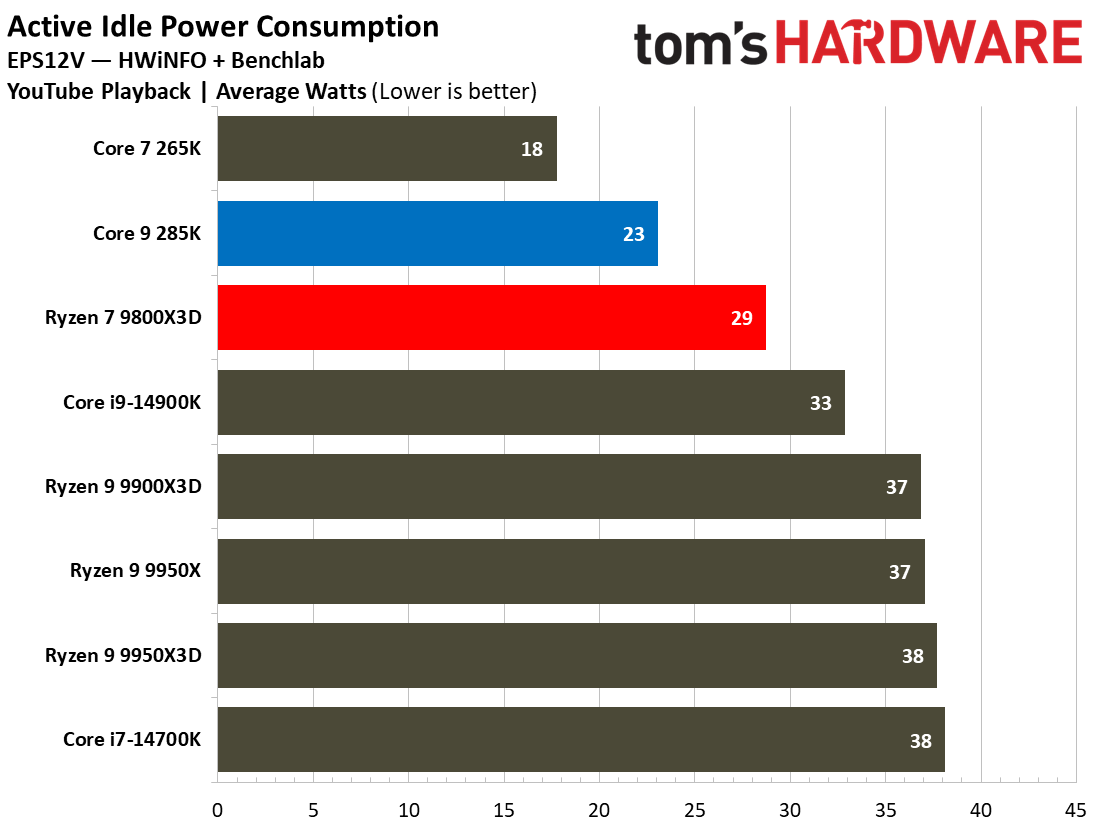
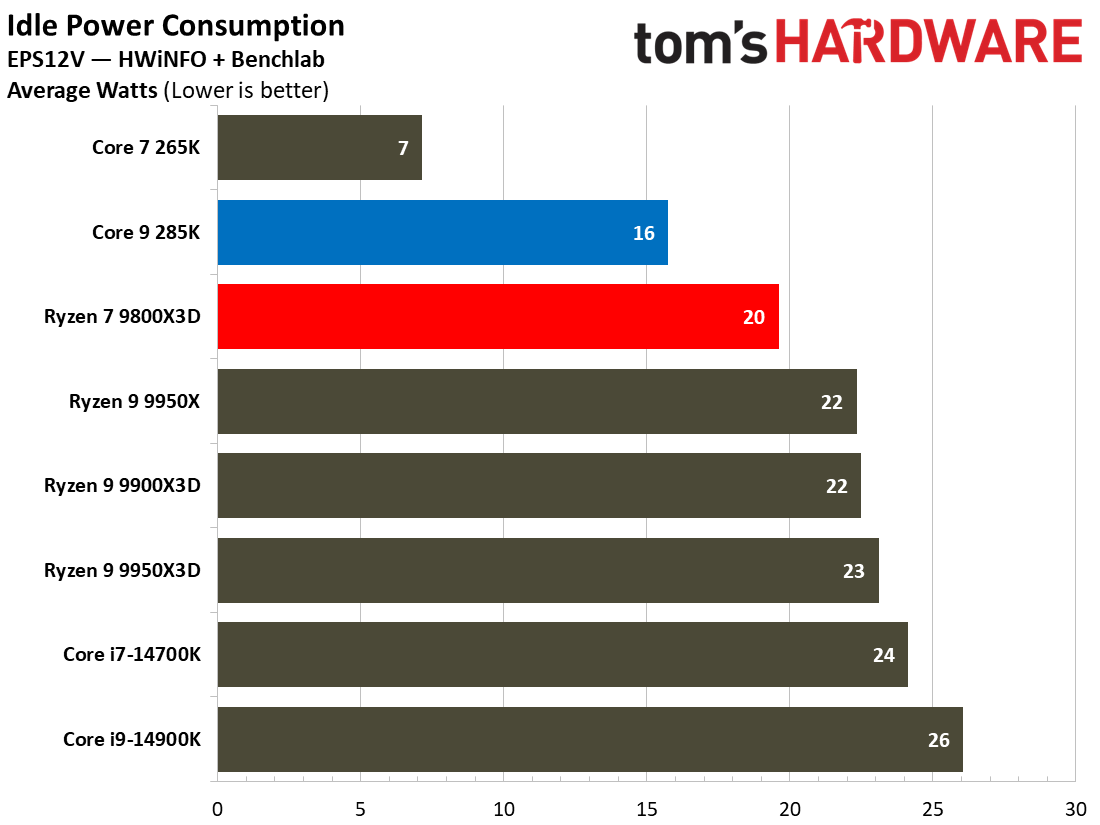

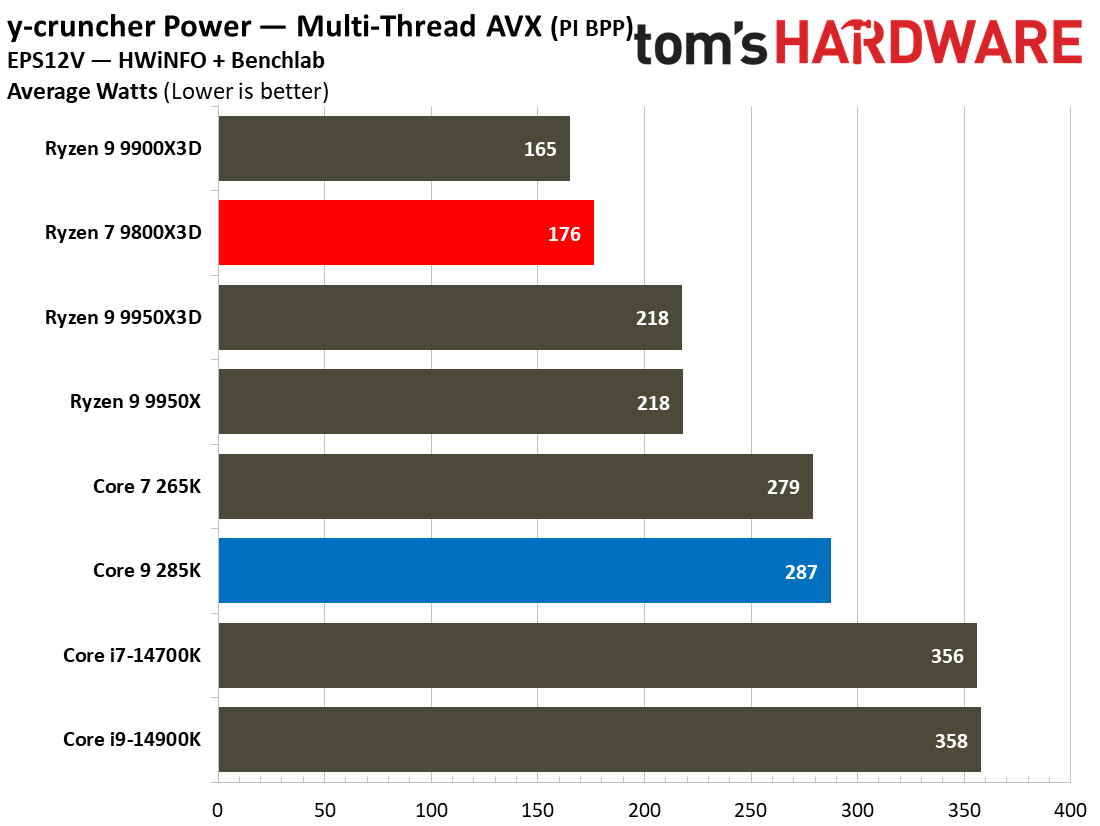
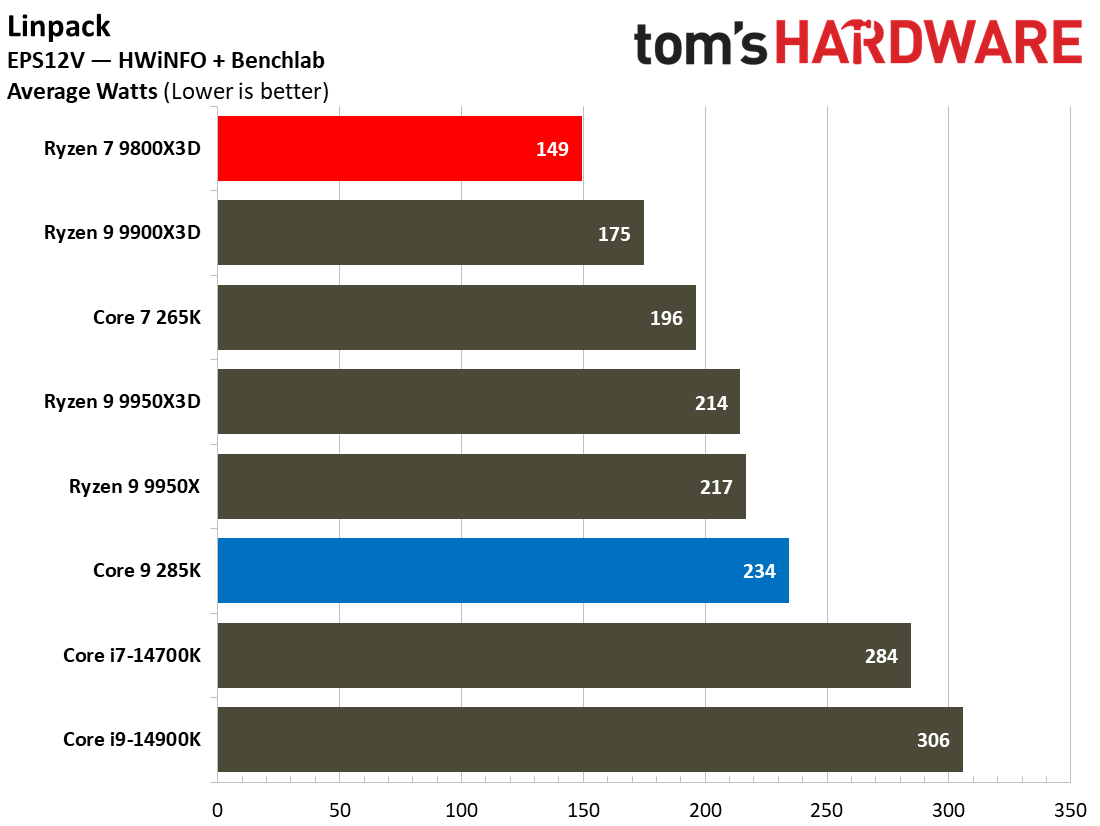
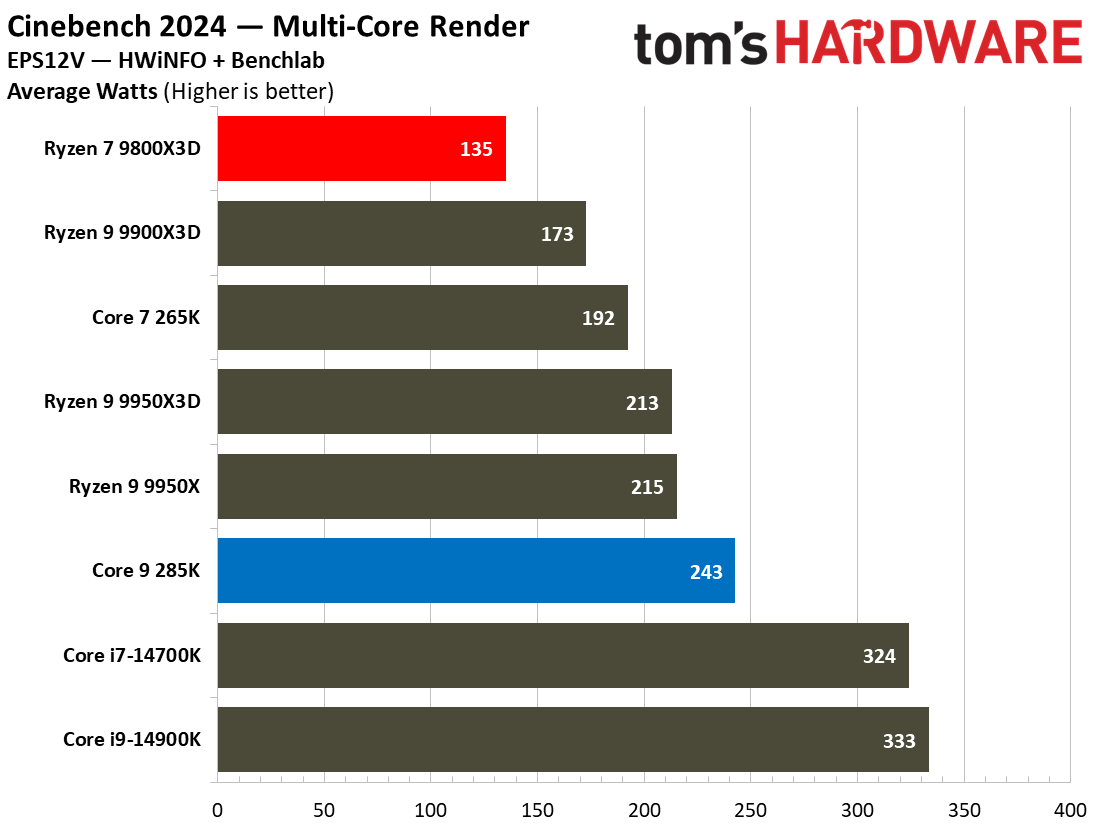
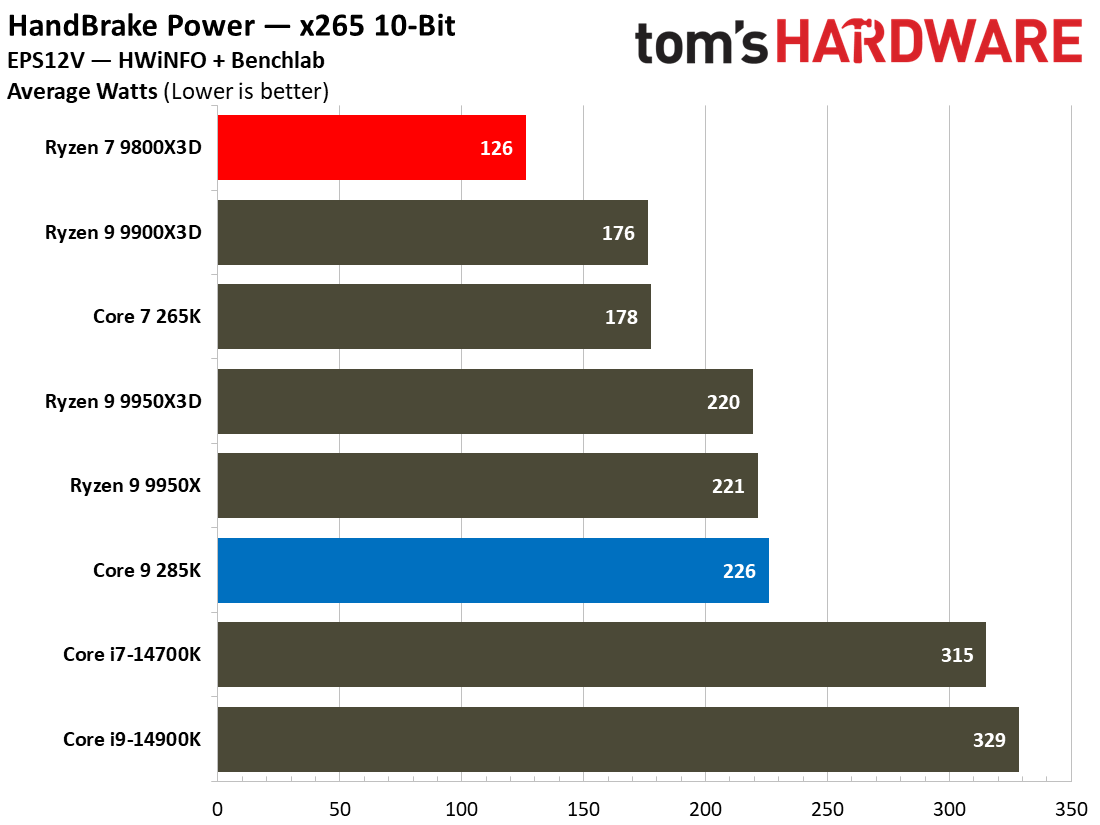
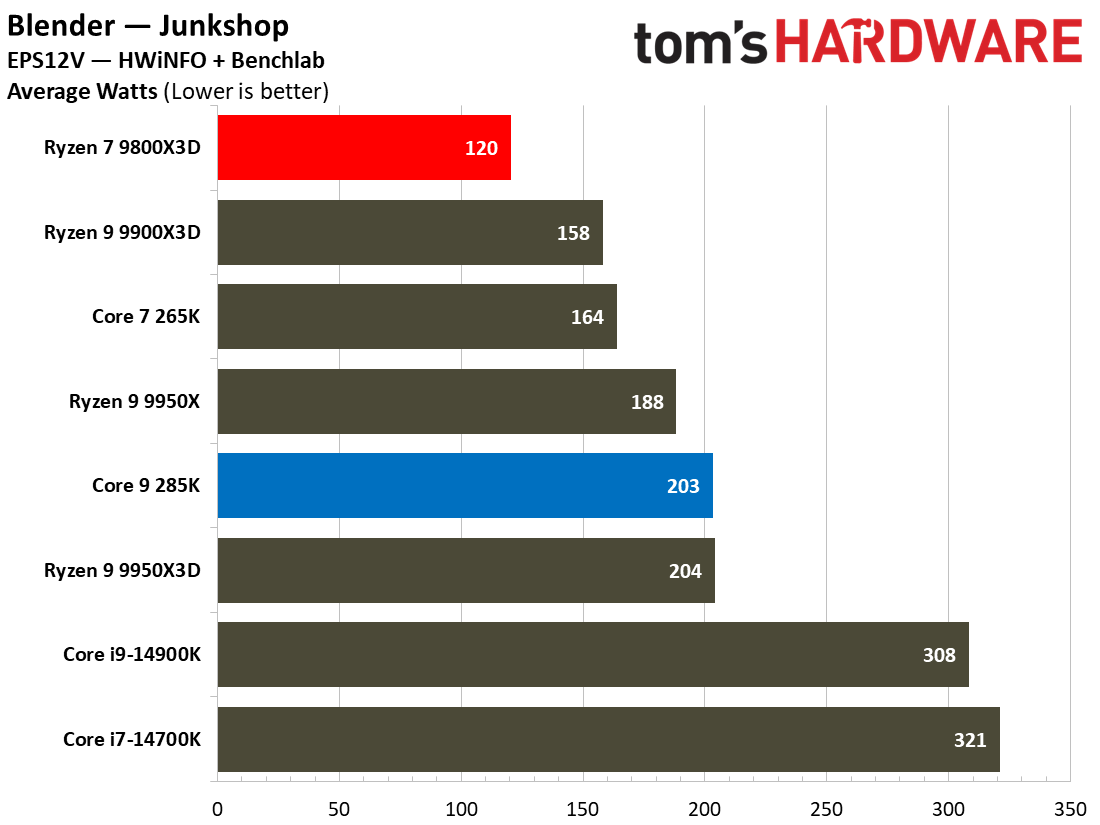
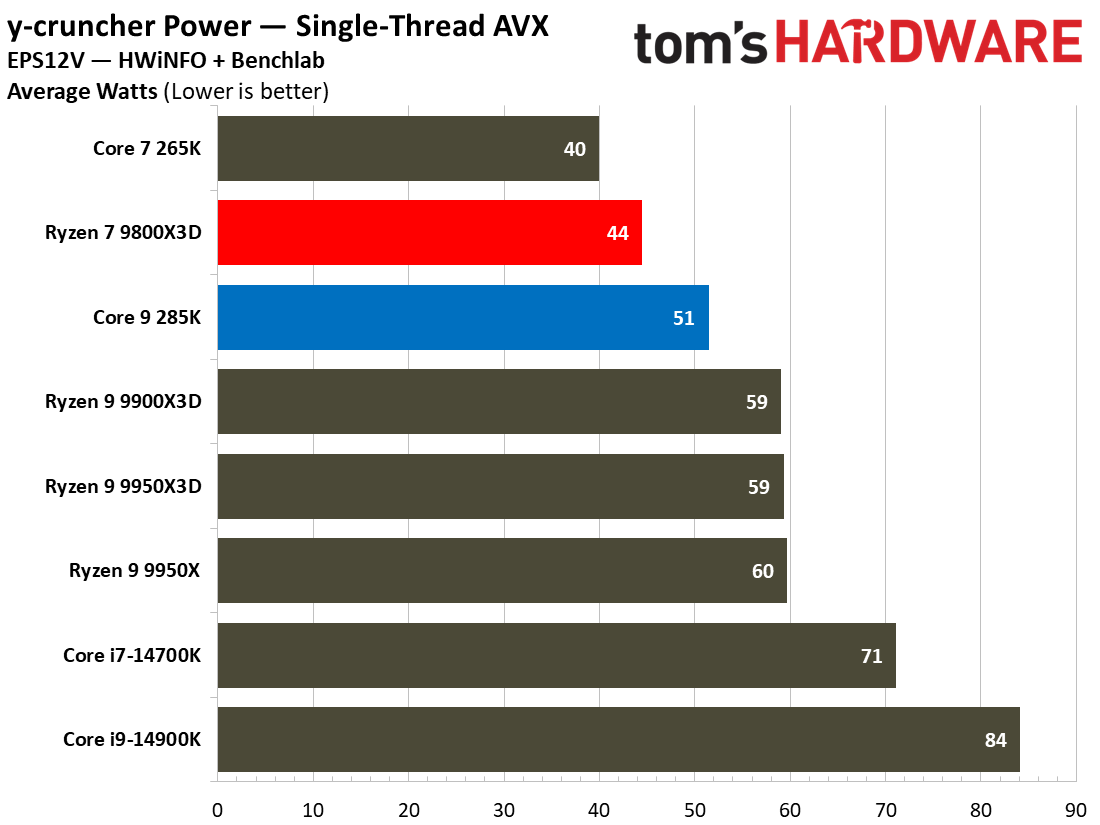

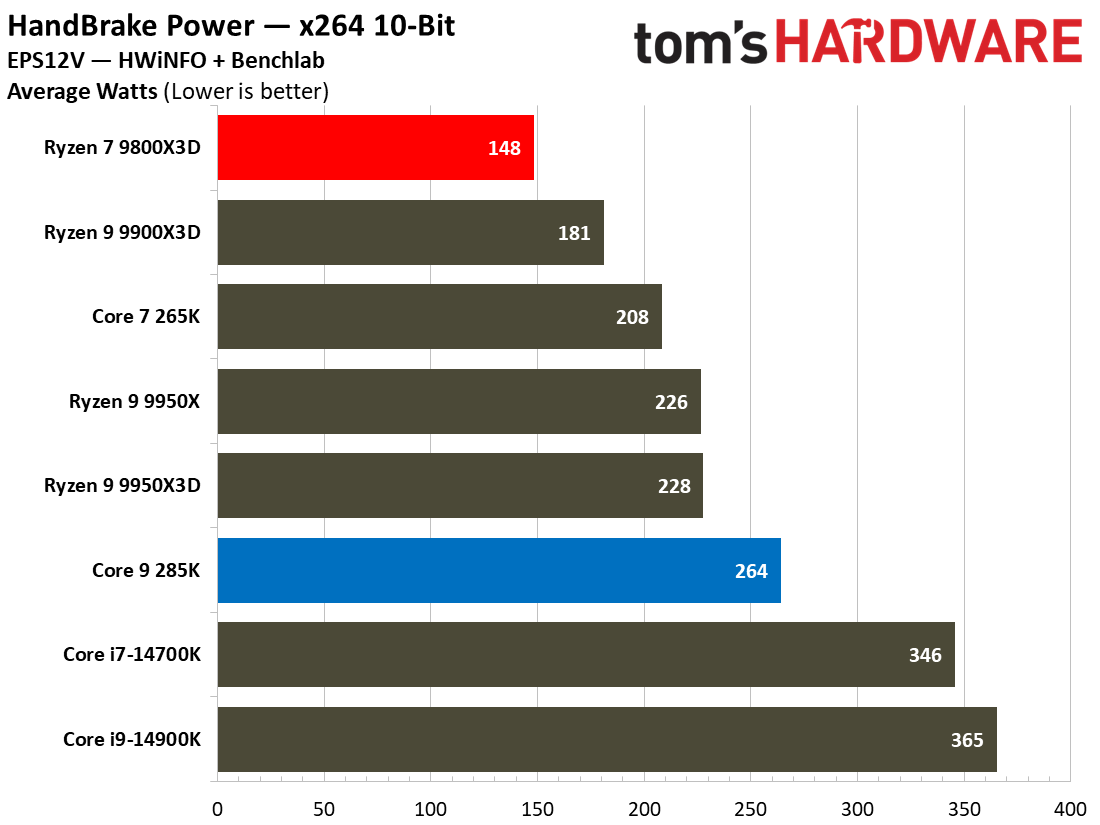
In idle states, the Intel Core Ultra 9 285K demonstrates superior efficiency compared to the AMD Ryzen 7 9800X3D. The pure idle power consumption test shows the Core Ultra 9 285K drawing just 16 watts compared to the Ryzen 7 9800X3D's 20 watts, representing a 20% power advantage for Intel. This difference is relatively consistent when examining the active idle scenario (such as during YouTube playback), where Intel's chip consumes 23 watts versus AMD's 29 watts, maintaining a 20.7% efficiency advantage. Intel's architecture appears more optimized for low-power states, which could benefit users who leave their systems idle for extended periods.
Under heavy multi-threaded AVX workloads, the Ryzen 7 9800X3D showcases dramatically better efficiency. In the y-cruncher benchmark, the AMD chip consumes 176W, while the Core 9 285K draws 287W—a staggering 63% more power for Intel. In the Prime95 benchmark with AVX instructions enabled (representing intensive workloads), the Core Ultra 9 285K draws a substantial 325 watts of power, while the Ryzen 7 9800X3D consumes just 171 watts. This represents a staggering 90% higher power consumption for the Intel processor, which is offset by higher performance.
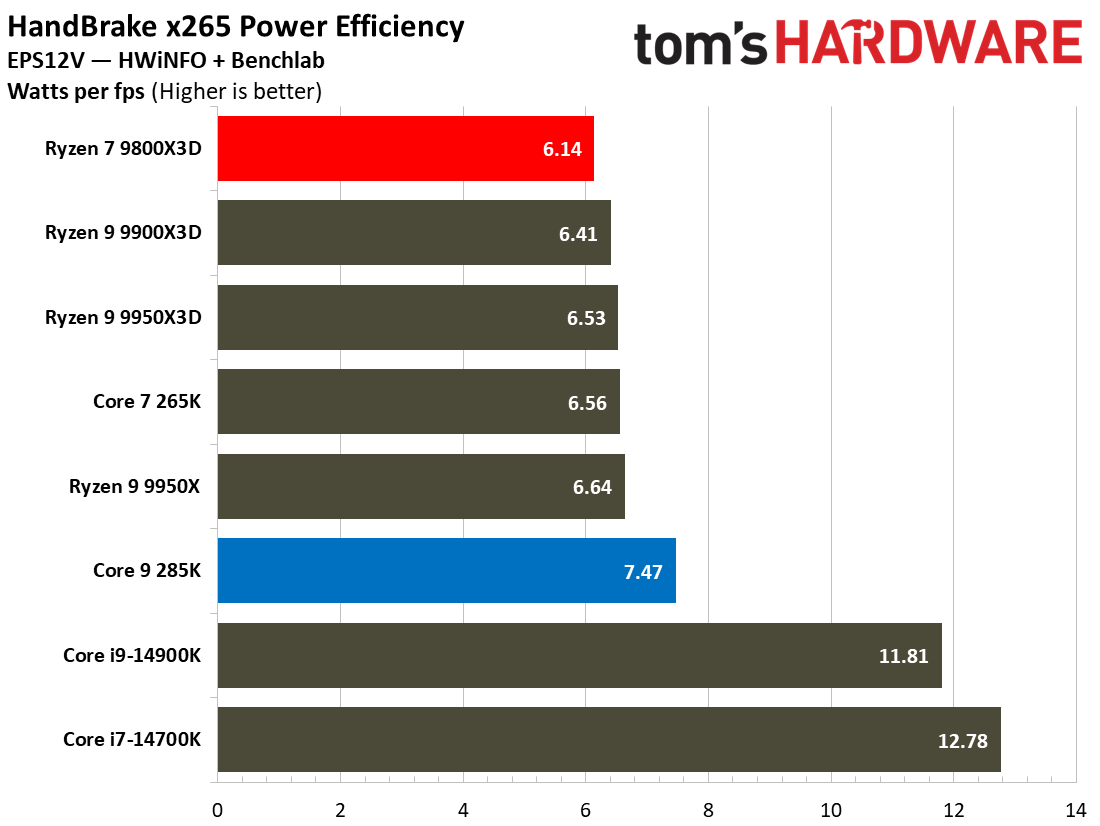

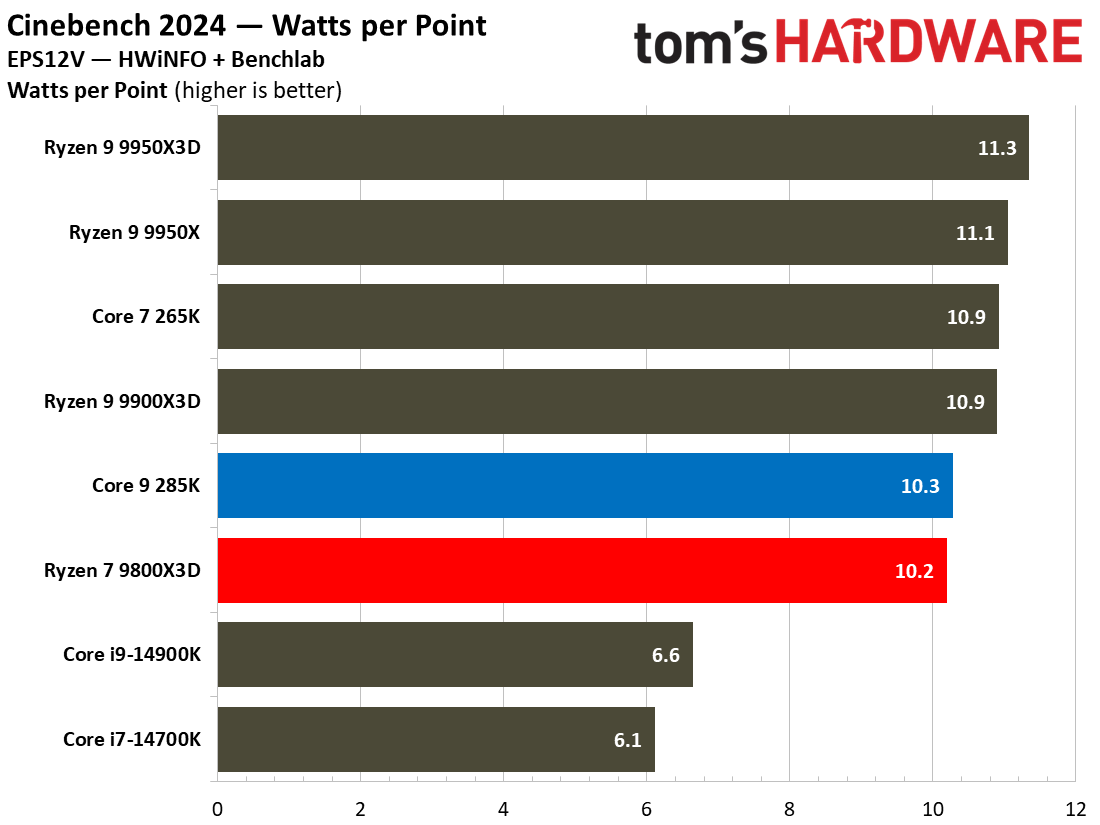
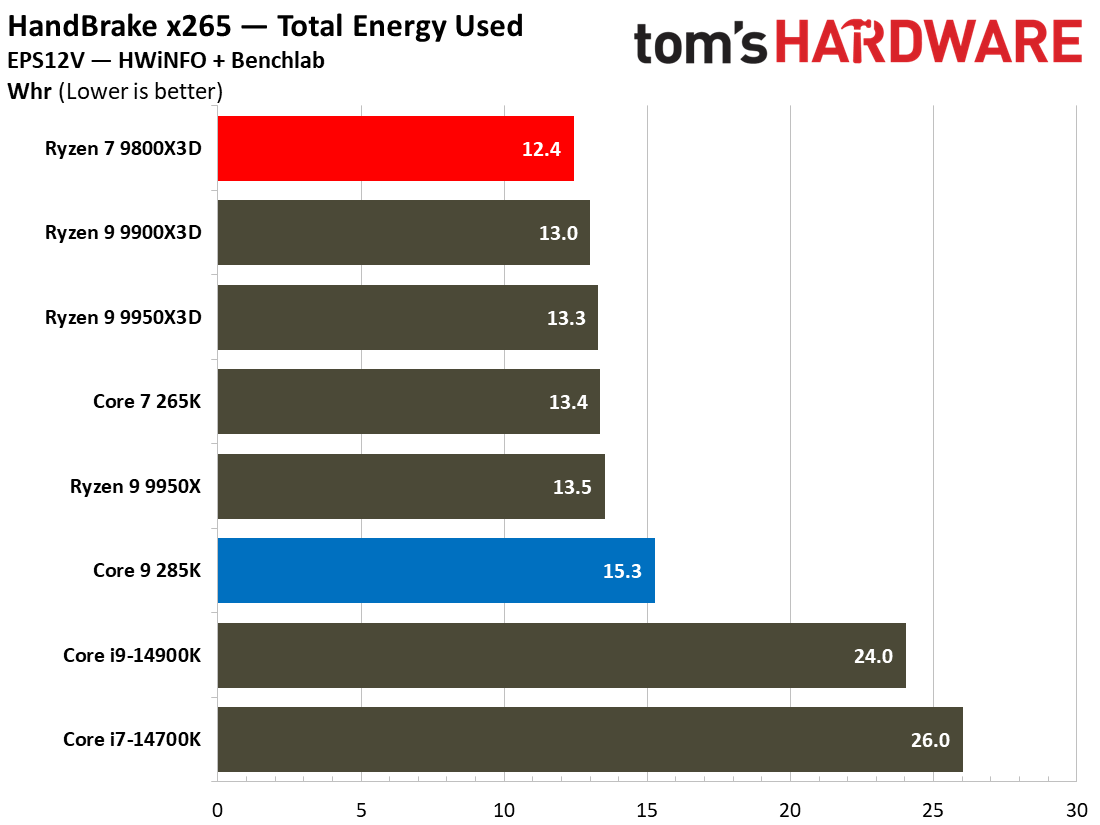
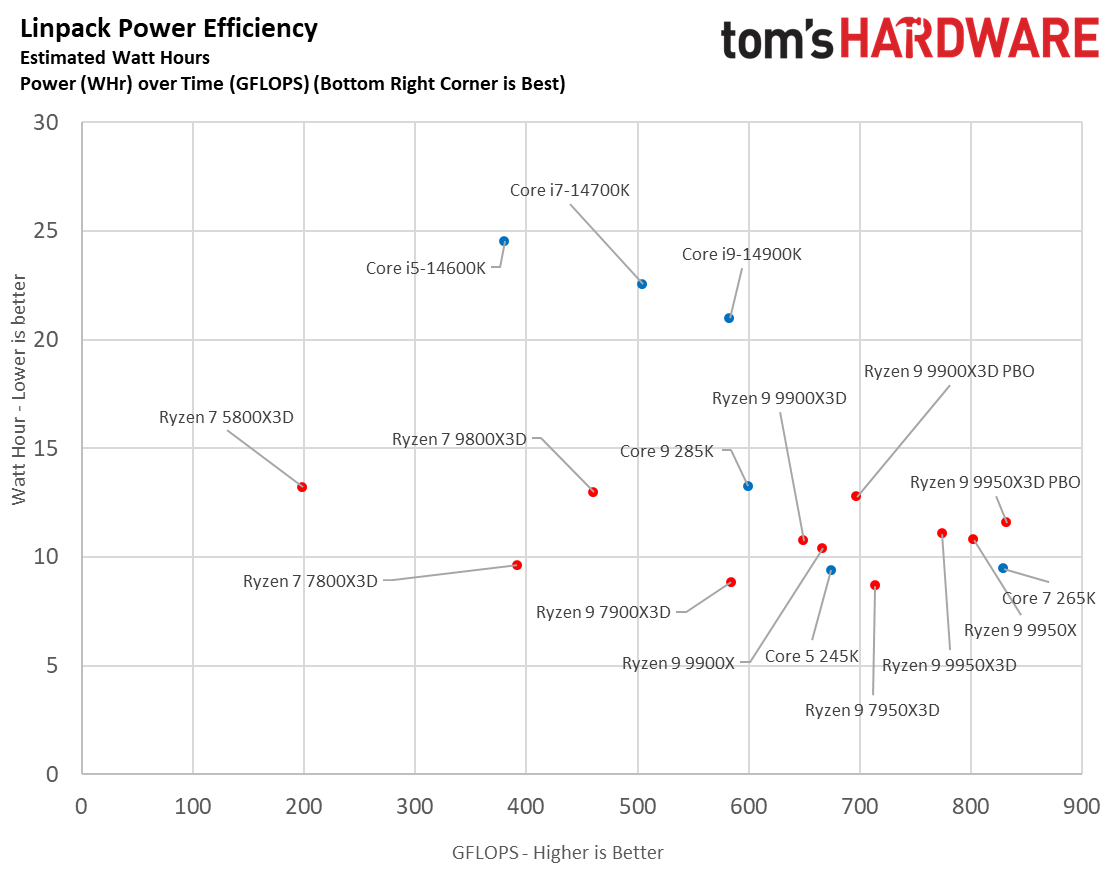
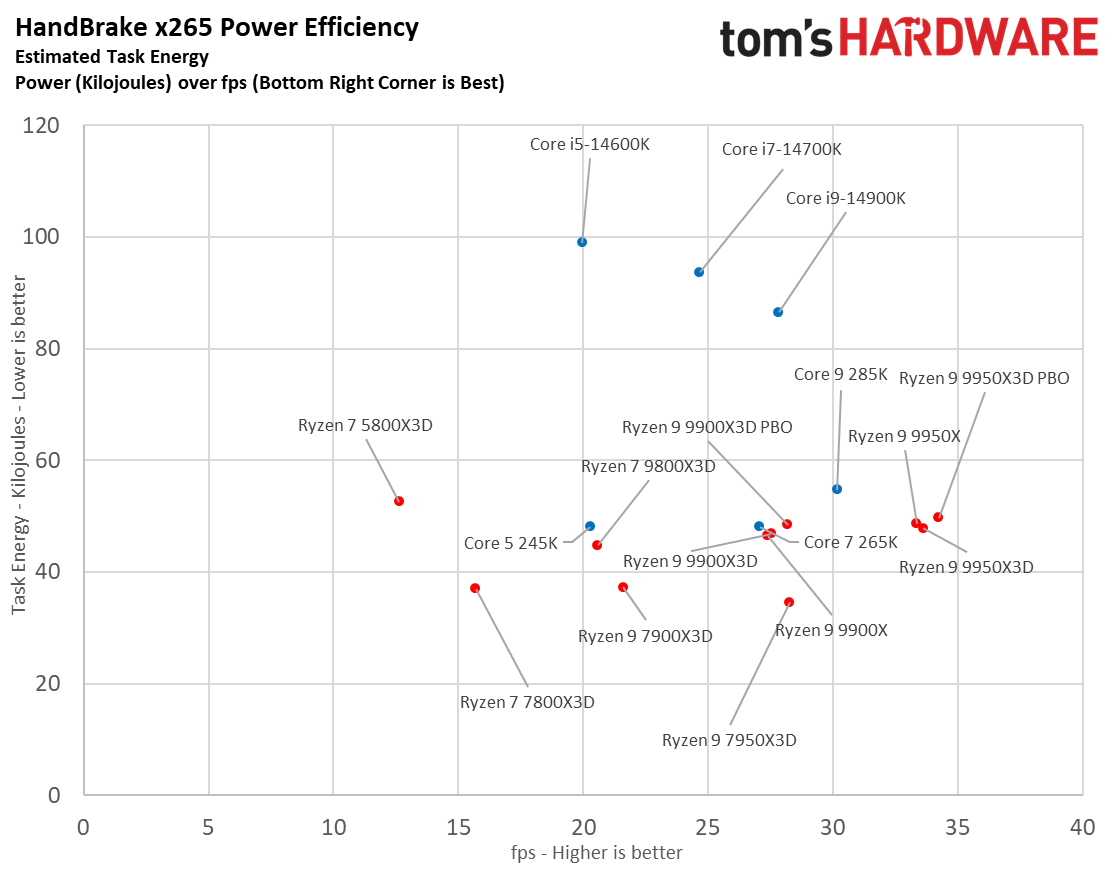
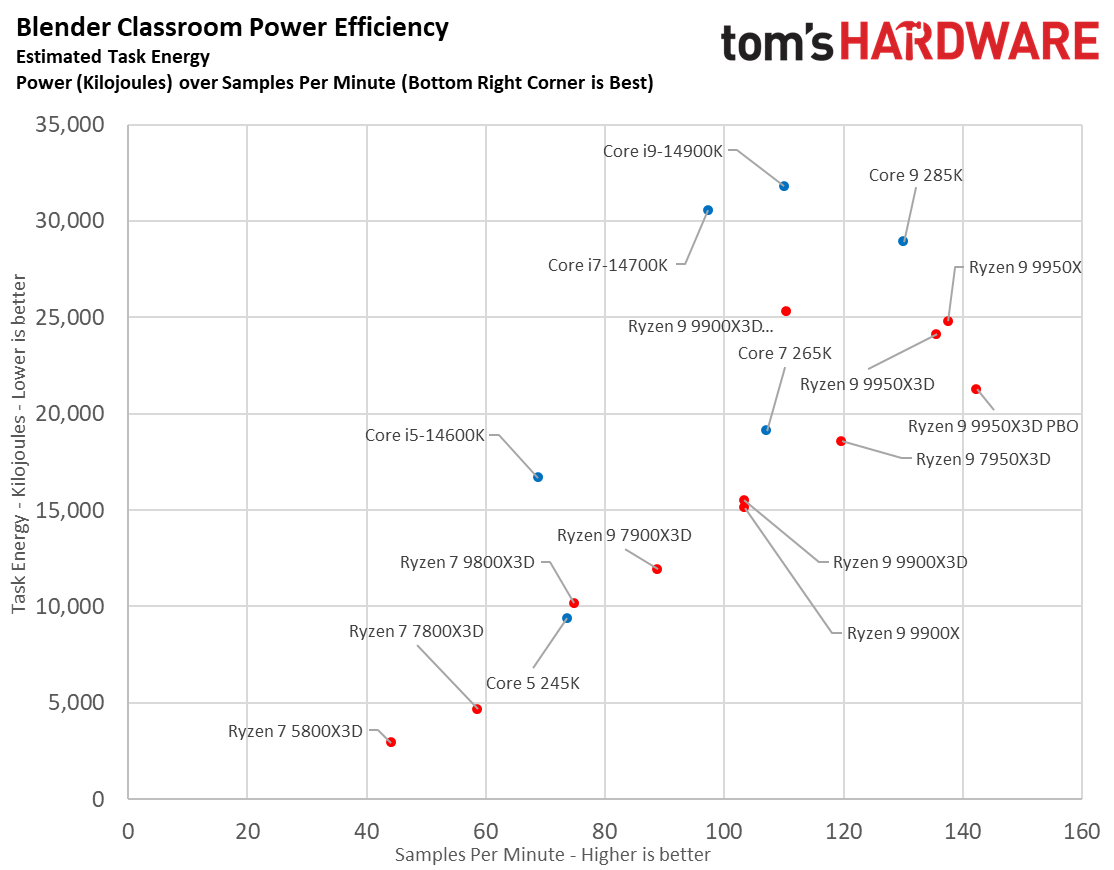
In our efficiency benchmarks, the results are mixed. The Core 9 285K edges out the Ryzen 7 9800X3D in Cinebench 2024’s “Watts per Point” metric, scoring 10.3 vs. AMD’s 10.2 (higher is better). However, this marginal 1% difference pales compared to the y-cruncher disparity.
The Blender Classroom efficiency chart offers perhaps the most illuminating comparison of real-world efficiency. This benchmark plots task energy (in kilojoules) against performance (samples per minute), with the ideal position being the bottom-right corner, where more performance is achieved with less energy.
The Core Ultra 9 285K delivers approximately 120-130 samples per minute but requires around 29,000-32,000 kilojoules to do so. In contrast, the Ryzen 7 9800X3D delivers fewer samples (approximately 80-90 per minute) but consumes dramatically less energy at approximately 10,000-12,000 kilojoules. This means that while Intel's processor is roughly 40-50% faster in raw performance, it consumes nearly three times the energy to achieve this performance advantage, making the AMD solution significantly more efficient on a performance-per-watt basis.
Cooling requirements align closely with power consumption, as higher wattage translates to greater heat output. The Intel Core Ultra 9 285K’s peak load consumption of 325 watts in Prime95 demands robust cooling, potentially a 360mm AIO liquid cooler, to manage temperatures effectively, especially given that its thermal output could exceed 90°C under stress.
In contrast, the Ryzen 7 9800X3D’s 171 watts in the same test consumes roughly half the power, which is manageable with a mid-range air cooler or a 240mm AIO, keeping temperatures below 80°C. Even at idle, the 7-watt difference (16W vs. 20W) is negligible for cooling compared to load demands. Thus, the Ryzen 7 9800X3D’s lower thermal profile makes it significantly easier to cool, reducing system costs and noise levels.
🏆Winner: AMD
Based on the comprehensive power consumption data, the AMD Ryzen 7 9800X3D emerges as the clearly superior choice for energy efficiency, particularly under load conditions where the difference is most pronounced. While Intel's Core Ultra 9 285K does hold a 20% advantage in idle power consumption, this benefit is overshadowed by its substantially higher power draw during actual computation tasks.
For users prioritizing energy efficiency, lower heat output, quieter operation, or systems with limited cooling capacity, the Ryzen 7 9800X3D represents a significantly better option. The Intel processor may justify its higher power consumption only in specific use cases where its raw performance advantage outweighs efficiency concerns; however, in most scenarios, AMD's offering delivers a much better balance of performance and power consumption.
Pricing: Intel Core Ultra 9 285K vs AMD Ryzen 7 9800X3D
Intel launched the Core Ultra 9 285K with a price tag of $620, but nowadays it can be found retailing for around $590. At first glance, the Ryzen 7 9800X3D holds a clear price advantage, retailing at $480 compared to the Core Ultra 9 285K’s $590 price tag—a $119 (20%) savings on the CPU alone. However, platform costs (such as motherboard, RAM, and cooling) must be taken into consideration when evaluating the overall value proposition of modern CPUs.
Intel’s LGA 1851 platform (and the new 800-series chipsets) demands premium pricing for full feature access, with mid-range boards averaging between $250–$300. AMD’s AM5 platform, although initially more expensive, now offers budget-friendly B650 boards starting at $150–$200, providing comparable PCIe 5.0 and even overclocking support. You can even step up to an X670 motherboard, and the overall platform cost will still be lower than a comparable Intel setup.
The Ryzen 7 9800X3D also benefits from AM5’s longevity, with AMD committing to socket support through 2025+, allowing for future upgrades without requiring a motherboard swap. Intel’s LGA 1851 is expected to last only 1–2 generations, limiting long-term value. Both CPUs use DDR5 RAM, but AMD’s EXPO optimization often allows tighter timings at similar costs.
The Core 9 285K’s has a higher peak power draw, as we have already discussed, which necessitates a high-end air cooler ($80–$100) or a 240 mm+ AIO liquid cooler ($120+). In contrast, the Ryzen 7 9800X3D’s lower peak power draw can be managed with a mid-range air cooler ($40–$60), saving quite a decent chunk of change.
The Ryzen 7 9800X3D dominates in power-sensitive workloads (e.g., 63% lower power draw in y-cruncher), reducing long-term electricity costs for heavy users. While the Core 9 285K edges ahead in lightly threaded tasks, even though this marginal advantage doesn’t offset its platform premium. For gaming, AMD’s 3D V-Cache typically delivers superior frame rates, further justifying its value.
🏆Winner: AMD
Combining all the categories, the Ryzen 7 9800X3D is the unequivocal value champion. Its significant platform savings, combined with superior efficiency, lower cooling demands, and future-proof AM5 compatibility, make it ideal for value-conscious builders and upgraders. For 95% of users—especially gamers—the Ryzen 7 9800X3D delivers higher performance per dollar and long-term savings.
While the Intel Core Ultra 9 285K offers stronger multi-core performance, its higher cost and greater cooling demands make it less appealing unless the user specifically requires its productivity-focused features.
Bottom Line: Intel Core Ultra 9 285K vs AMD Ryzen 7 9800X3D
| Row 0 - Cell 0 | Intel Core Ultra 9 285K | AMD Ryzen 7 9800X3D |
Features and Specifications | ❌ | ❌ |
Gaming | Row 2 - Cell 1 | ❌ |
Productivity Applications | ❌ | Row 3 - Cell 2 |
Overclocking | ❌ | Row 4 - Cell 2 |
Power Consumption, Efficiency, and Cooling | Row 5 - Cell 1 | ❌ |
Pricing | Row 6 - Cell 1 | ❌ |
Total | 3 | 4 |
The score chalks up to a 3 to 4 win in the Ryzen 7 9800X3D vs Intel Core Ultra 9 285K showdown, with the win going to the 9800X3D. However, while the score reveals the winner, the reality is a bit murkier given the distinct price tiers and target markets for these chips.
Neither the Intel Core Ultra 285K nor the AMD Ryzen 7 9800X3D emerges as the undisputed champion of both gaming and productivity disciplines in a direct head-to-head comparison. Instead, their strengths align with distinct user priorities.
For gamers, the Ryzen 7 9800X3D’s 3D V-Cache delivers a tangible edge, significantly reducing latency in titles that thrive on rapid data access, making it the go-to choice for high-refresh 1080p or 1440p gaming.
Conversely, the Core Ultra 285K’s hybrid architecture, with its 24 cores and aggressive boost clocks, excels in productivity workloads such as video rendering, 3D modeling, and multitasking, where thread count and raw throughput are more crucial. This split highlights a recurring industry trend: AMD optimizes for specialized efficiency, while Intel focuses on multi-threaded scalability.
The price-to-performance conversation further tilts the scales. The Ryzen 7 9800X3D not only undercuts Intel’s offering in cost but also leverages AM5 platform longevity, allowing users to upgrade CPUs without replacing motherboards—a boon for budget-conscious builders. Intel’s LGA1851 platform, while future-proofed, demands a pricier motherboard overhaul.
However, the Core Ultra 285K justifies its premium with higher performance in productivity workloads, Thunderbolt 4 support, and higher DDR5 speeds, appealing to professionals needing cutting-edge I/O or memory bandwidth. Value here is subjective: AMD caters to cost-aware gamers, while Intel targets power users willing to invest in top-tier productivity.
⭐Winner: AMD
The AMD Ryzen 7 9800X3D comes out on top in our faceoff, but there's plenty of nuance. While this chip is a stellar performer for gaming and presents a wonderful value, it simply can't match the 285K's prowess in productivity workloads. That's not surprising, given the price delta.
Ultimately, the decision hinges on use case and personal preference. If gaming dominates your workload, the Ryzen’s cache advantage and lower thermal footprint make it irresistible — the Ryzen 7 9800X3D remains the undisputed gaming champion in this general price range. For creators and professionals, Intel’s hybrid cores and frequency headroom offer stronger performance in demanding tasks, leaving it a smaller audience in enthusiast builds.
Both CPUs excel within their niches, reflecting a market where specialization trumps one-size-fits-all solutions. Your choice isn’t about what's “better”—it’s about what’s better for you.
More CPU Faceoffs

Hassam Nasir is a die-hard hardware enthusiast with years of experience as a tech editor and writer, focusing on detailed CPU comparisons and general hardware news. When he’s not working, you’ll find him bending tubes for his ever-evolving custom water-loop gaming rig or benchmarking the latest CPUs and GPUs just for fun.
- Paul AlcornEditor-in-Chief
-
HyperMatrix Garbage article. I knew from the start that there was going to be some attempt to make Intel look less bad. 4 to 3. Lol. Even the 14900K gives the 285K a bigger beating than that. Don’t call it battle of the gaming flagships if you’re not going to focus on…you know…gaming. Where the 285K doesn’t stand a chance.Reply -
Kindaian The additional issue that is not addressed in the article is the fact that Intel has a mix of performance and economy cores.Reply
And the hidden secret is that on some workloads, the wrong core is selected, meaning that you get subpar and rubbish performance (even when the performance cores are snoozing around, doing nothing).
So, yes, Intel does have on those two specific CPUs some multi-thread advantage, but only if the correct cores are selected (which doesn't happen 100% of the time).
Also in terms of performance, you also need to measure latency. What is the point of having a fast memory interface, if the cache chokes and needs to constantly being updated from the slower memory? At that point, having a slightly faster memory does help, but again, depends on the workloads (and the comparison is using also productivity multi-threading, so not 100% game oriented this comparison).
Also I would like to see the comparison per watt used, and not just a raw performance. -
Paul Alcorn Reply
Thanks for the feedback. We do mention that Intel chips have different types of cores, and ultimately, the proof is in the pudding, which is the application benchmarks. Theoretical comparisons are always great, but the end performance tells the tale.Kindaian said:The additional issue that is not addressed in the article is the fact that Intel has a mix of performance and economy cores.
And the hidden secret is that on some workloads, the wrong core is selected, meaning that you get subpar and rubbish performance (even when the performance cores are snoozing around, doing nothing).
So, yes, Intel does have on those two specific CPUs some multi-thread advantage, but only if the correct cores are selected (which doesn't happen 100% of the time).
Also in terms of performance, you also need to measure latency. What is the point of having a fast memory interface, if the cache chokes and needs to constantly being updated from the slower memory? At that point, having a slightly faster memory does help, but again, depends on the workloads (and the comparison is using also productivity multi-threading, so not 100% game oriented this comparison).
Also I would like to see the comparison per watt used, and not just a raw performance.
We do have detailed performance-per-watt and power efficiency metrics in the power section. -
Paul Alcorn Reply
My life would be much simpler if there were users who simply turned on their computer, loaded a game, and only played the game (no web browser, no Discord, no anything), then shut down the computer. That use case really doesn't exist, at least not for the overwhelming majority of users. So the onus is on us to fully quantify these competing processors in every facet that impacts the purchasing decision. Yes, that includes things other than gaming.HyperMatrix said:Garbage article. I knew from the start that there was going to be some attempt to make Intel look less bad. 4 to 3. Lol. Even the 14900K gives the 285K a bigger beating than that. Don’t call it battle of the gaming flagships if you’re not going to focus on…you know…gaming. Where the 285K doesn’t stand a chance.
There is no attempt here to deny the 9800X3D's dominance in gaming. In fact, it is spelled out multiple times in the article, too many for me to waste my time here quoting them. It is also the top processor on our list of Best CPUs for Gaming. We have always offered nothing but effusive praise for the 9800X3D in gaming, and this article is no different. It starts at the first sentence and ends in the conclusion, with more than enough statements to that fact in between. -
redgarl This comparison should have been against the 9950x3D.Reply
What is the point of comparing a 24 cores CPU flagship against the entry 8 cores CPU... and telling it is better at productivity than the 8 cores offering.
And you guys stated GAMING FACE-OFF on the thumbnail... but you still include productivity scores? If it is a gaming face-off, then the weighting of the scores about GAMING should be way more important.
It is not a GAMING face-off, it is a plain 430$ vs 600$+ CPU face-off at this point.
Man, I am about to start a youtube channel call TechInfluencers and put all this nonsense there... It is breathtaking.
The worst is seeing Paul doing some kind of damage control about it just above.
https://i.ibb.co/39670ytM/Untitled.jpg -
Paul Alcorn Reply
Please re-read the title, as I believe you are interpreting it wrong. The first half of the headline says this is a faceoff of two processors; it does not say this is a gaming-only faceoff. The second half points out that these are gaming flagships.redgarl said:This comparison should have been against the 9950x3D.
What is the point of comparing a 24 cores CPU flagship against the entry 8 cores CPU... and telling it is better at productivity than the 8 cores offering.
And you guys stated GAMING FACE-OFF on the thumbnails... but you still include productivity scores?
Man, I am about to start a youtube channel call TechInfluencers and put all this nonsense there...
It is breathtaking to see such nonsense.
The thought process here is simple:
The Core Ultra 9 285K is Intel's gaming flagship.
The Ryzen 7 9800X3D is AMD's gaming flagship.
Let's compare them. Fully. The Core Ultra 9 285K vs Ryzen 7 9800X3D.
I can assure you we would have far more complaints if we left out productivity work and power metrics, thus being so myopic as to assume gaming is all that colors someone's purchasing decision on a $590 processor, not to mention all of the other costs required to integrate it into a build.
Additionally, the categories for all our CPU faceoffs are the same, regardless of the processors under examination. This is to ensure consistency in the most relevant factors and also prevent claims that we are merely tailoring the articles to fit a predetermined narrative.
We have a separate comparison of the 285K vs 9950X3D, which is linked in the article multiple times. -
HyperMatrix Reply
As another commenter mentioned…you decided to label this as a gaming article, then went into productivity, somehow gave Intel the win in overclocking, didn’t match it against the more similar 9950X3D, and also fully ignore the issues around thread scheduling for gaming, on this gaming benchmark, which was actually one of the top reasons I moved away from Intel.PaulAlcorn said:My life would be much simpler if there were users who simply turned on their computer, loaded a game, and only played the game (no web browser, no Discord, no anything), then shut down the computer. That use case really doesn't exist, at least not for the overwhelming majority of users. So the onus is on us to fully quantify these competing processors in every facet that impacts the purchasing decision. Yes, that includes things other than gaming.
There is no attempt here to deny the 9800X3D's dominance in gaming. In fact, it is spelled out multiple times in the article, too many for me to waste my time here quoting them. It is also the top processor on our list of Best CPUs for Gaming. We have always offered nothing but effusive praise for the 9800X3D in gaming, and this article is no different. It starts at the first sentence and ends in the conclusion, with more than enough statements to that fact in between. -
A Stoner I'll give you kudos since everyone else is attacking you.Reply
I came into this, after reading the title, knowing this was going to be an Intel props post.
But you did not give that to me. Instead, you gave a fair comparison of the 2 chips giving AMD wins it deserves, and Intel wins where it deserves.
Drop the 'gaming' in the title and I think most people's ability to attack would go away. -
Paul Alcorn Reply
I can present an article title to you, but I cannot comprehend it for you. Re-read the title. At no point does it state that this is a "gaming faceoff." Please read my response prior to your comment.HyperMatrix said:As another commenter mentioned…you decided to label this as a gaming article, then went into productivity, somehow gave Intel the win in overclocking, didn’t match it against the more similar 9950X3D, and also fully ignore the issues around thread scheduling for gaming, on this gaming benchmark, which was actually one of the top reasons I moved away from Intel.